Northwest Hills Planning Region, CT
Northwest Hills Planning Region Overview
112,696
TOTAL POPULATION
55,997
MALE POPULATION
56,699
FEMALE POPULATION
98.76
MALES / 100 FEMALES
101.25
FEMALES / 100 MALES
45.1
MEDIAN AGE
2.9
AVG FAMILY SIZE
2.4
AVG HOUSEHOLD SIZE
$52,279
PER CAPITA INCOME
$108,548
AVG FAMILY INCOME
$87,971
AVG HOUSEHOLD INCOME
25.3%
WAGE / INCOME GAP [ % ]
74.7¢/ $1
WAGE / INCOME GAP [ $ ]
$10,773
FAMILY INCOME DEFICIT
0.48
INEQUALITY / GINI INDEX
61,373
LABOR FORCE [ PEOPLE ]
65.4%
PERCENT IN LABOR FORCE
5.4%
UNEMPLOYMENT RATE
Race in Northwest Hills Planning Region
The most populous races in Northwest Hills Planning Region are White / Caucasian (92,804 | 82.4%), Hispanic or Latino (12,232 | 10.8%), and Two or more Races (8,468 | 7.5%).

| Race | # Population | % Population |
| Asian | 2,811 | 2.5% |
| Black / African American | 5,352 | 4.8% |
| Hawaiian / Pacific | 0 | 0.0% |
| Hispanic or Latino | 12,232 | 10.8% |
| Native / Alaskan | 154 | 0.1% |
| White / Caucasian | 92,804 | 82.4% |
| Two or more Races | 8,468 | 7.5% |
| Some other Race | 3,107 | 2.8% |
| Total | 112,696 | 100.0% |
Ancestry in Northwest Hills Planning Region
The most populous ancestries reported in Northwest Hills Planning Region are Italian (20,234 | 17.9%), Irish (19,360 | 17.2%), English (14,981 | 13.3%), German (12,582 | 11.2%), and Polish (7,727 | 6.9%), together accounting for 66.4% of all Northwest Hills Planning Region residents.
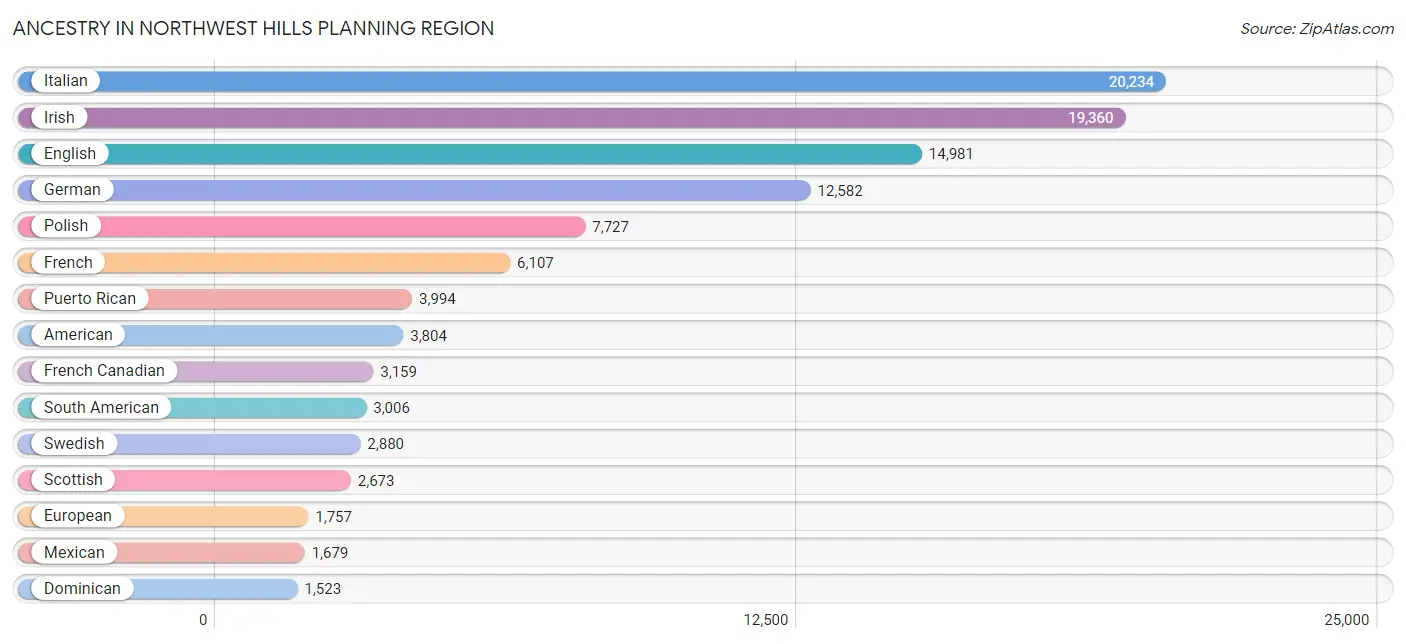
| Ancestry | # Population | % Population |
| African | 888 | 0.8% |
| Albanian | 199 | 0.2% |
| Alsatian | 107 | 0.1% |
| American | 3,804 | 3.4% |
| Apache | 9 | 0.0% |
| Arab | 490 | 0.4% |
| Argentinean | 57 | 0.1% |
| Armenian | 72 | 0.1% |
| Assyrian / Chaldean / Syriac | 11 | 0.0% |
| Australian | 46 | 0.0% |
| Austrian | 379 | 0.3% |
| Belgian | 62 | 0.1% |
| Bhutanese | 434 | 0.4% |
| Blackfeet | 97 | 0.1% |
| Bolivian | 13 | 0.0% |
| Brazilian | 59 | 0.1% |
| British | 877 | 0.8% |
| British West Indian | 34 | 0.0% |
| Burmese | 996 | 0.9% |
| Canadian | 566 | 0.5% |
| Cape Verdean | 35 | 0.0% |
| Carpatho Rusyn | 7 | 0.0% |
| Celtic | 41 | 0.0% |
| Central American | 881 | 0.8% |
| Central American Indian | 47 | 0.0% |
| Cherokee | 303 | 0.3% |
| Chilean | 62 | 0.1% |
| Colombian | 833 | 0.7% |
| Costa Rican | 94 | 0.1% |
| Creek | 17 | 0.0% |
| Croatian | 35 | 0.0% |
| Cuban | 263 | 0.2% |
| Czech | 673 | 0.6% |
| Czechoslovakian | 313 | 0.3% |
| Danish | 525 | 0.5% |
| Dominican | 1,523 | 1.3% |
| Dutch | 800 | 0.7% |
| Eastern European | 809 | 0.7% |
| Ecuadorian | 1,363 | 1.2% |
| Egyptian | 6 | 0.0% |
| English | 14,981 | 13.3% |
| Estonian | 18 | 0.0% |
| Ethiopian | 83 | 0.1% |
| European | 1,757 | 1.6% |
| Filipino | 5 | 0.0% |
| Finnish | 205 | 0.2% |
| French | 6,107 | 5.4% |
| French American Indian | 34 | 0.0% |
| French Canadian | 3,159 | 2.8% |
| German | 12,582 | 11.2% |
| Ghanaian | 86 | 0.1% |
| Greek | 425 | 0.4% |
| Guatemalan | 676 | 0.6% |
| Haitian | 12 | 0.0% |
| Hungarian | 899 | 0.8% |
| Indian (Asian) | 894 | 0.8% |
| Indonesian | 65 | 0.1% |
| Iranian | 24 | 0.0% |
| Irish | 19,360 | 17.2% |
| Iroquois | 29 | 0.0% |
| Israeli | 27 | 0.0% |
| Italian | 20,234 | 17.9% |
| Jamaican | 549 | 0.5% |
| Japanese | 237 | 0.2% |
| Korean | 619 | 0.5% |
| Laotian | 152 | 0.1% |
| Latvian | 19 | 0.0% |
| Lebanese | 443 | 0.4% |
| Liberian | 79 | 0.1% |
| Lithuanian | 1,111 | 1.0% |
| Macedonian | 16 | 0.0% |
| Malaysian | 225 | 0.2% |
| Mexican | 1,679 | 1.5% |
| Mexican American Indian | 31 | 0.0% |
| Native Hawaiian | 73 | 0.1% |
| Nicaraguan | 23 | 0.0% |
| Nigerian | 120 | 0.1% |
| Northern European | 169 | 0.2% |
| Norwegian | 804 | 0.7% |
| Pakistani | 16 | 0.0% |
| Palestinian | 6 | 0.0% |
| Panamanian | 16 | 0.0% |
| Paraguayan | 136 | 0.1% |
| Peruvian | 429 | 0.4% |
| Polish | 7,727 | 6.9% |
| Portuguese | 635 | 0.6% |
| Puerto Rican | 3,994 | 3.5% |
| Romanian | 185 | 0.2% |
| Russian | 1,379 | 1.2% |
| Salvadoran | 72 | 0.1% |
| Samoan | 24 | 0.0% |
| Scandinavian | 215 | 0.2% |
| Scotch-Irish | 513 | 0.5% |
| Scottish | 2,673 | 2.4% |
| Serbian | 31 | 0.0% |
| Slavic | 217 | 0.2% |
| Slovak | 845 | 0.7% |
| Slovene | 31 | 0.0% |
| Somali | 1 | 0.0% |
| South African | 8 | 0.0% |
| South American | 3,006 | 2.7% |
| South American Indian | 57 | 0.1% |
| Soviet Union | 28 | 0.0% |
| Spaniard | 211 | 0.2% |
| Spanish | 326 | 0.3% |
| Sri Lankan | 314 | 0.3% |
| Subsaharan African | 1,214 | 1.1% |
| Swedish | 2,880 | 2.6% |
| Swiss | 433 | 0.4% |
| Syrian | 43 | 0.0% |
| Thai | 292 | 0.3% |
| Turkish | 4 | 0.0% |
| U.S. Virgin Islander | 15 | 0.0% |
| Ukrainian | 393 | 0.4% |
| Uruguayan | 28 | 0.0% |
| Venezuelan | 85 | 0.1% |
| Welsh | 544 | 0.5% |
| Yaqui | 30 | 0.0% |
| Yugoslavian | 106 | 0.1% | View All 119 Rows |
Immigrants in Northwest Hills Planning Region
The most numerous immigrant groups reported in Northwest Hills Planning Region came from Latin America (4,336 | 3.8%), Europe (3,136 | 2.8%), Asia (2,142 | 1.9%), South America (2,072 | 1.8%), and Eastern Europe (1,279 | 1.1%), together accounting for 11.5% of all Northwest Hills Planning Region residents.
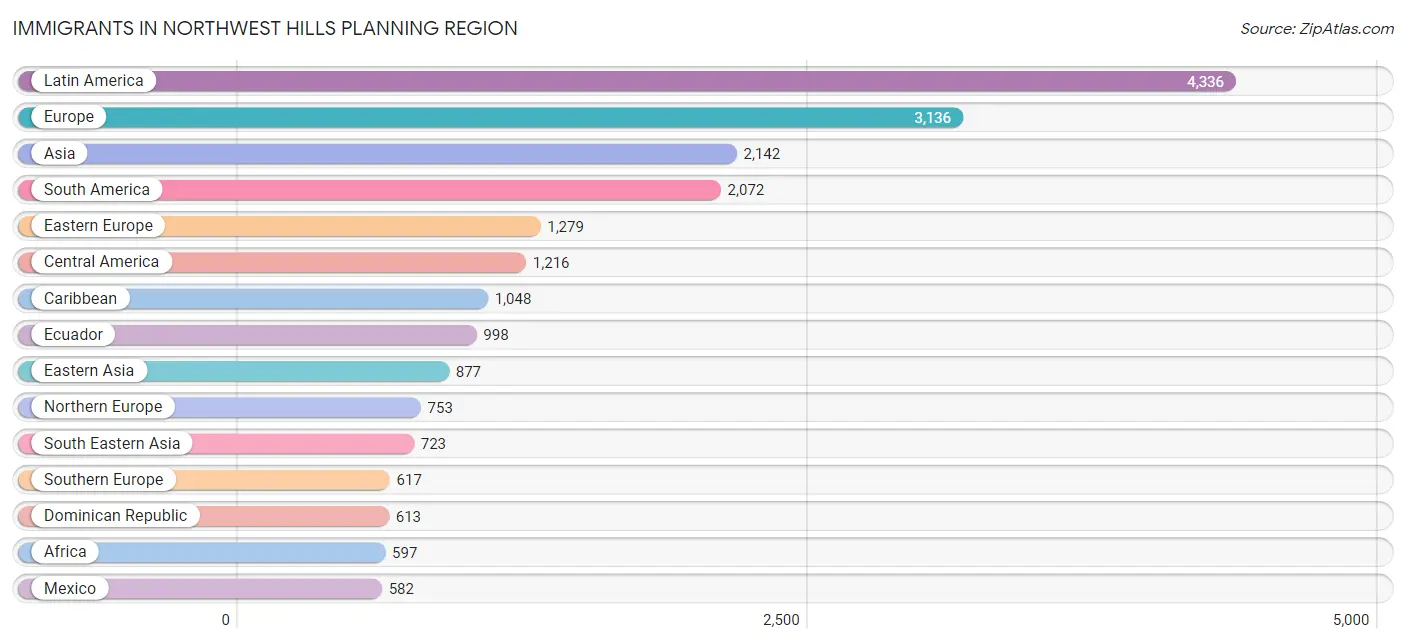
| Immigration Origin | # Population | % Population |
| Africa | 597 | 0.5% |
| Albania | 106 | 0.1% |
| Argentina | 15 | 0.0% |
| Asia | 2,142 | 1.9% |
| Australia | 62 | 0.1% |
| Austria | 18 | 0.0% |
| Azores | 3 | 0.0% |
| Bangladesh | 159 | 0.1% |
| Belarus | 51 | 0.1% |
| Bolivia | 13 | 0.0% |
| Bosnia and Herzegovina | 146 | 0.1% |
| Brazil | 261 | 0.2% |
| Cambodia | 42 | 0.0% |
| Canada | 443 | 0.4% |
| Caribbean | 1,048 | 0.9% |
| Central America | 1,216 | 1.1% |
| Chile | 16 | 0.0% |
| China | 328 | 0.3% |
| Colombia | 429 | 0.4% |
| Costa Rica | 91 | 0.1% |
| Croatia | 16 | 0.0% |
| Cuba | 17 | 0.0% |
| Czechoslovakia | 23 | 0.0% |
| Denmark | 4 | 0.0% |
| Dominican Republic | 613 | 0.5% |
| Eastern Africa | 78 | 0.1% |
| Eastern Asia | 877 | 0.8% |
| Eastern Europe | 1,279 | 1.1% |
| Ecuador | 998 | 0.9% |
| England | 288 | 0.3% |
| Ethiopia | 74 | 0.1% |
| Europe | 3,136 | 2.8% |
| France | 114 | 0.1% |
| Germany | 260 | 0.2% |
| Ghana | 172 | 0.2% |
| Greece | 63 | 0.1% |
| Guatemala | 504 | 0.4% |
| Hong Kong | 57 | 0.1% |
| Hungary | 50 | 0.0% |
| India | 127 | 0.1% |
| Indonesia | 94 | 0.1% |
| Iran | 8 | 0.0% |
| Ireland | 83 | 0.1% |
| Israel | 27 | 0.0% |
| Italy | 411 | 0.4% |
| Jamaica | 384 | 0.3% |
| Japan | 86 | 0.1% |
| Korea | 463 | 0.4% |
| Laos | 134 | 0.1% |
| Latin America | 4,336 | 3.8% |
| Latvia | 12 | 0.0% |
| Lebanon | 24 | 0.0% |
| Liberia | 49 | 0.0% |
| Lithuania | 79 | 0.1% |
| Malaysia | 37 | 0.0% |
| Mexico | 582 | 0.5% |
| Netherlands | 52 | 0.1% |
| Nicaragua | 23 | 0.0% |
| North Macedonia | 79 | 0.1% |
| Northern Europe | 753 | 0.7% |
| Norway | 8 | 0.0% |
| Oceania | 62 | 0.1% |
| Pakistan | 120 | 0.1% |
| Panama | 16 | 0.0% |
| Peru | 247 | 0.2% |
| Philippines | 286 | 0.3% |
| Poland | 473 | 0.4% |
| Portugal | 34 | 0.0% |
| Romania | 4 | 0.0% |
| Russia | 108 | 0.1% |
| Saudi Arabia | 11 | 0.0% |
| Scotland | 77 | 0.1% |
| Sierra Leone | 109 | 0.1% |
| South America | 2,072 | 1.8% |
| South Central Asia | 460 | 0.4% |
| South Eastern Asia | 723 | 0.6% |
| Southern Europe | 617 | 0.5% |
| Spain | 109 | 0.1% |
| Sri Lanka | 36 | 0.0% |
| Sweden | 162 | 0.1% |
| Switzerland | 43 | 0.0% |
| Taiwan | 20 | 0.0% |
| Thailand | 29 | 0.0% |
| Ukraine | 97 | 0.1% |
| Uruguay | 8 | 0.0% |
| Uzbekistan | 10 | 0.0% |
| Venezuela | 85 | 0.1% |
| Vietnam | 101 | 0.1% |
| Western Africa | 510 | 0.4% |
| Western Asia | 68 | 0.1% |
| Western Europe | 487 | 0.4% |
| Yemen | 6 | 0.0% | View All 92 Rows |
Sex and Age in Northwest Hills Planning Region
Sex and Age in Northwest Hills Planning Region
The most populous age groups in Northwest Hills Planning Region are 60 to 64 Years (4,799 | 8.6%) for men and 60 to 64 Years (5,177 | 9.1%) for women.
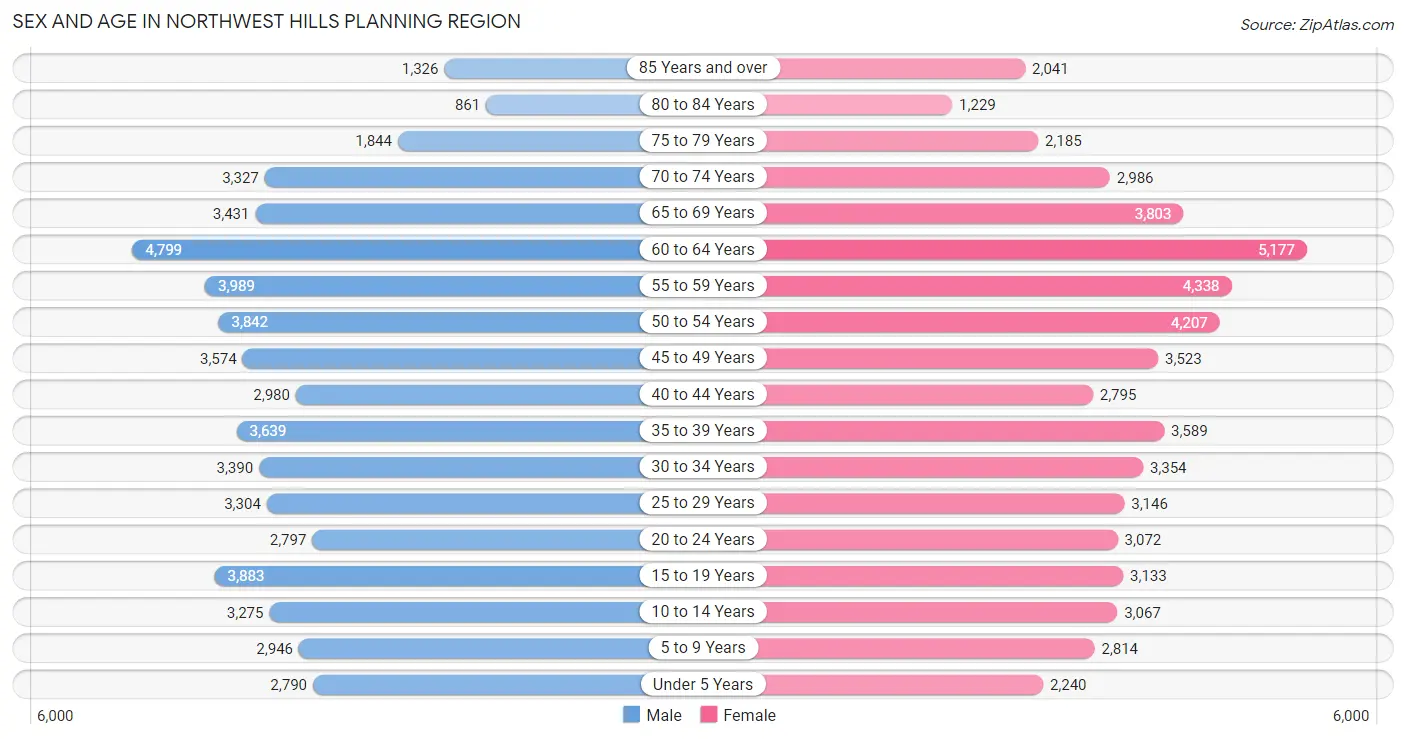
| Age Bracket | Male | Female |
| Under 5 Years | 2,790 (5.0%) | 2,240 (4.0%) |
| 5 to 9 Years | 2,946 (5.3%) | 2,814 (5.0%) |
| 10 to 14 Years | 3,275 (5.9%) | 3,067 (5.4%) |
| 15 to 19 Years | 3,883 (6.9%) | 3,133 (5.5%) |
| 20 to 24 Years | 2,797 (5.0%) | 3,072 (5.4%) |
| 25 to 29 Years | 3,304 (5.9%) | 3,146 (5.6%) |
| 30 to 34 Years | 3,390 (6.0%) | 3,354 (5.9%) |
| 35 to 39 Years | 3,639 (6.5%) | 3,589 (6.3%) |
| 40 to 44 Years | 2,980 (5.3%) | 2,795 (4.9%) |
| 45 to 49 Years | 3,574 (6.4%) | 3,523 (6.2%) |
| 50 to 54 Years | 3,842 (6.9%) | 4,207 (7.4%) |
| 55 to 59 Years | 3,989 (7.1%) | 4,338 (7.6%) |
| 60 to 64 Years | 4,799 (8.6%) | 5,177 (9.1%) |
| 65 to 69 Years | 3,431 (6.1%) | 3,803 (6.7%) |
| 70 to 74 Years | 3,327 (5.9%) | 2,986 (5.3%) |
| 75 to 79 Years | 1,844 (3.3%) | 2,185 (3.8%) |
| 80 to 84 Years | 861 (1.5%) | 1,229 (2.2%) |
| 85 Years and over | 1,326 (2.4%) | 2,041 (3.6%) |
| Total | 55,997 (100.0%) | 56,699 (100.0%) |
Families and Households in Northwest Hills Planning Region
Median Family Size in Northwest Hills Planning Region
The median family size in Northwest Hills Planning Region is 2.93 persons per family, with married-couple families (22,670 | 76.2%) accounting for the largest median family size of 2.98 persons per family. On the other hand, single male/father families (2,167 | 7.3%) represent the smallest median family size with 2.76 persons per family.

| Family Type | # Families | Family Size |
| Married-Couple | 22,670 (76.2%) | 2.98 |
| Single Male/Father | 2,167 (7.3%) | 2.76 |
| Single Female/Mother | 4,898 (16.5%) | 2.81 |
| Total Families | 29,735 (100.0%) | 2.93 |
Median Household Size in Northwest Hills Planning Region
The median household size in Northwest Hills Planning Region is 2.40 persons per household, with single male/father households (2,167 | 4.7%) accounting for the largest median household size of 3.26 persons per household. non-family households (16,241 | 35.3%) represent the smallest median household size with 1.22 persons per household.

| Household Type | # Households | Household Size |
| Married-Couple | 22,670 (49.3%) | 3.01 |
| Single Male/Father | 2,167 (4.7%) | 3.26 |
| Single Female/Mother | 4,898 (10.6%) | 3.12 |
| Non-family | 16,241 (35.3%) | 1.22 |
| Total Households | 45,976 (100.0%) | 2.40 |
Household Size by Marriage Status in Northwest Hills Planning Region
Out of a total of 45,976 households in Northwest Hills Planning Region, 29,735 (64.7%) are family households, while 16,241 (35.3%) are nonfamily households. The most numerous type of family households are 2-person households, comprising 14,140, and the most common type of nonfamily households are 1-person households, comprising 13,092.

| Household Size | Family Households | Nonfamily Households |
| 1-Person Households | - | 13,092 (28.5%) |
| 2-Person Households | 14,140 (30.8%) | 2,773 (6.0%) |
| 3-Person Households | 6,992 (15.2%) | 132 (0.3%) |
| 4-Person Households | 5,471 (11.9%) | 206 (0.4%) |
| 5-Person Households | 2,275 (5.0%) | 3 (0.0%) |
| 6-Person Households | 596 (1.3%) | 0 (0.0%) |
| 7+ Person Households | 261 (0.6%) | 35 (0.1%) |
| Total | 29,735 (64.7%) | 16,241 (35.3%) |
Female Fertility in Northwest Hills Planning Region
Fertility by Age in Northwest Hills Planning Region
Average fertility rate in Northwest Hills Planning Region is 42.0 births per 1,000 women. Women in the age bracket of 20 to 34 years have the highest fertility rate with 57.0 births per 1,000 women. Women in the age bracket of 20 to 34 years acount for 55.0% of all women with births.

| Age Bracket | Women with Births | Births / 1,000 Women |
| 15 to 19 years | 32 (3.3%) | 10.0 |
| 20 to 34 years | 541 (55.0%) | 57.0 |
| 35 to 50 years | 411 (41.8%) | 39.0 |
| Total | 984 (100.0%) | 42.0 |
Fertility by Age by Marriage Status in Northwest Hills Planning Region
67.2% of women with births (984) in Northwest Hills Planning Region are married. The highest percentage of unmarried women with births falls into 15 to 19 years age bracket with 100.0% of them unmarried at the time of birth, while the lowest percentage of unmarried women with births belong to 35 to 50 years age bracket with 19.7% of them unmarried.

| Age Bracket | Married | Unmarried |
| 15 to 19 years | 0 (0.0%) | 32 (100.0%) |
| 20 to 34 years | 331 (61.2%) | 210 (38.8%) |
| 35 to 50 years | 330 (80.3%) | 81 (19.7%) |
| Total | 661 (67.2%) | 323 (32.8%) |
Fertility by Education in Northwest Hills Planning Region
Average fertility rate in Northwest Hills Planning Region is 42.0 births per 1,000 women. Women with the education attainment of bachelor's degree have the highest fertility rate of 54.0 births per 1,000 women, while women with the education attainment of less than high school have the lowest fertility at 23.0 births per 1,000 women. Women with the education attainment of bachelor's degree represent 28.9% of all women with births.
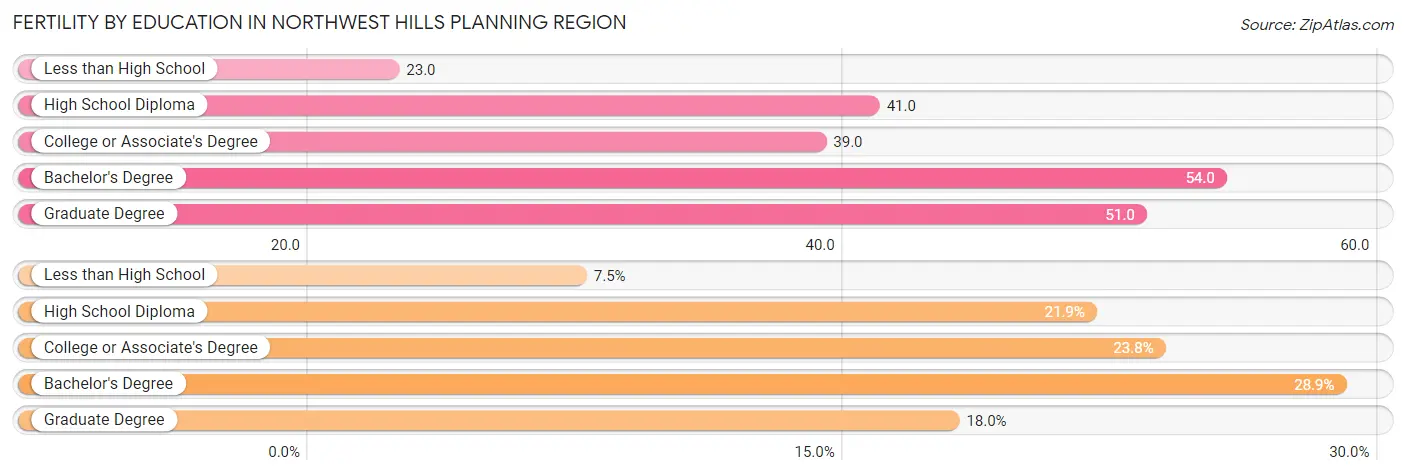
| Educational Attainment | Women with Births | Births / 1,000 Women |
| Less than High School | 74 (7.5%) | 23.0 |
| High School Diploma | 215 (21.8%) | 41.0 |
| College or Associate's Degree | 234 (23.8%) | 39.0 |
| Bachelor's Degree | 284 (28.9%) | 54.0 |
| Graduate Degree | 177 (18.0%) | 51.0 |
| Total | 984 (100.0%) | 42.0 |
Fertility by Education by Marriage Status in Northwest Hills Planning Region
32.8% of women with births in Northwest Hills Planning Region are unmarried. Women with the educational attainment of graduate degree are most likely to be married with 97.7% of them married at childbirth, while women with the educational attainment of high school diploma are least likely to be married with 77.7% of them unmarried at childbirth.

| Educational Attainment | Married | Unmarried |
| Less than High School | 20 (27.0%) | 54 (73.0%) |
| High School Diploma | 48 (22.3%) | 167 (77.7%) |
| College or Associate's Degree | 166 (70.9%) | 68 (29.1%) |
| Bachelor's Degree | 254 (89.4%) | 30 (10.6%) |
| Graduate Degree | 173 (97.7%) | 4 (2.3%) |
| Total | 661 (67.2%) | 323 (32.8%) |
Income in Northwest Hills Planning Region
Income Overview in Northwest Hills Planning Region
Per Capita Income in Northwest Hills Planning Region is $52,279, while median incomes of families and households are $108,548 and $87,971 respectively.
| Characteristic | Number | Measure |
| Per Capita Income | 112,696 | $52,279 |
| Median Family Income | 29,735 | $108,548 |
| Mean Family Income | 29,735 | $147,109 |
| Median Household Income | 45,976 | $87,971 |
| Mean Household Income | 45,976 | $125,814 |
| Income Deficit | 29,735 | $10,773 |
| Wage / Income Gap (%) | 112,696 | 25.34% |
| Wage / Income Gap ($) | 112,696 | 74.66¢ per $1 |
| Gini / Inequality Index | 112,696 | 0.48 |
Earnings by Sex in Northwest Hills Planning Region
Average Earnings in Northwest Hills Planning Region are $49,194, $57,277 for men and $42,762 for women, a difference of 25.3%.

| Sex | Number | Average Earnings |
| Male | 33,218 (52.1%) | $57,277 |
| Female | 30,520 (47.9%) | $42,762 |
| Total | 63,738 (100.0%) | $49,194 |
Earnings by Sex by Income Bracket in Northwest Hills Planning Region
The most common earnings brackets in Northwest Hills Planning Region are $100,000+ for men (7,422 | 22.3%) and $100,000+ for women (3,658 | 12.0%).
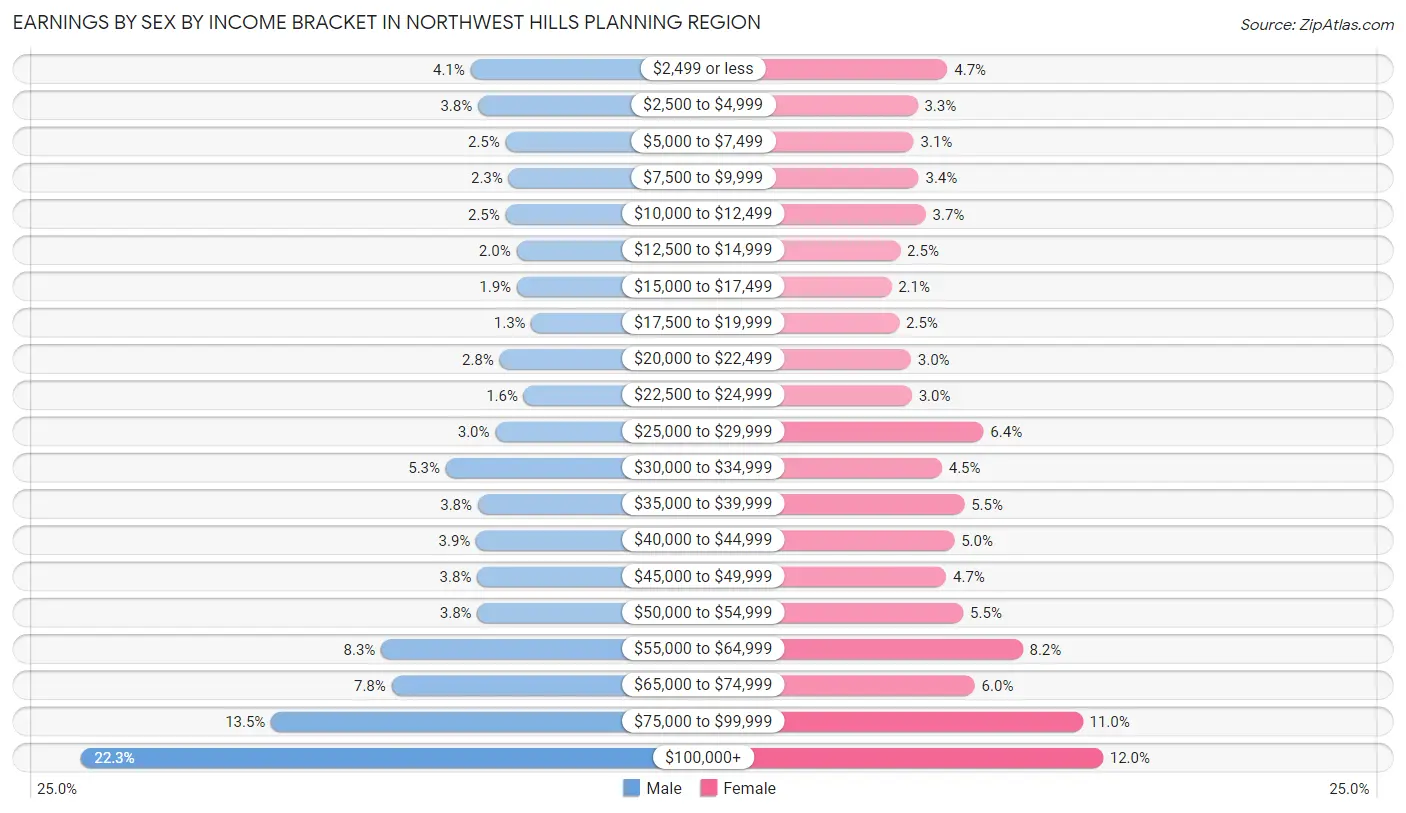
| Income | Male | Female |
| $2,499 or less | 1,365 (4.1%) | 1,439 (4.7%) |
| $2,500 to $4,999 | 1,249 (3.8%) | 1,010 (3.3%) |
| $5,000 to $7,499 | 821 (2.5%) | 954 (3.1%) |
| $7,500 to $9,999 | 773 (2.3%) | 1,026 (3.4%) |
| $10,000 to $12,499 | 821 (2.5%) | 1,127 (3.7%) |
| $12,500 to $14,999 | 652 (2.0%) | 763 (2.5%) |
| $15,000 to $17,499 | 646 (1.9%) | 634 (2.1%) |
| $17,500 to $19,999 | 419 (1.3%) | 749 (2.5%) |
| $20,000 to $22,499 | 913 (2.8%) | 917 (3.0%) |
| $22,500 to $24,999 | 538 (1.6%) | 928 (3.0%) |
| $25,000 to $29,999 | 979 (2.9%) | 1,954 (6.4%) |
| $30,000 to $34,999 | 1,749 (5.3%) | 1,357 (4.4%) |
| $35,000 to $39,999 | 1,252 (3.8%) | 1,679 (5.5%) |
| $40,000 to $44,999 | 1,279 (3.8%) | 1,535 (5.0%) |
| $45,000 to $49,999 | 1,262 (3.8%) | 1,418 (4.6%) |
| $50,000 to $54,999 | 1,258 (3.8%) | 1,664 (5.4%) |
| $55,000 to $64,999 | 2,758 (8.3%) | 2,511 (8.2%) |
| $65,000 to $74,999 | 2,593 (7.8%) | 1,828 (6.0%) |
| $75,000 to $99,999 | 4,469 (13.5%) | 3,369 (11.0%) |
| $100,000+ | 7,422 (22.3%) | 3,658 (12.0%) |
| Total | 33,218 (100.0%) | 30,520 (100.0%) |
Earnings by Sex by Educational Attainment in Northwest Hills Planning Region
Average earnings in Northwest Hills Planning Region are $64,210 for men and $47,903 for women, a difference of 25.4%. Men with an educational attainment of graduate degree enjoy the highest average annual earnings of $102,677, while those with less than high school education earn the least with $31,820. Women with an educational attainment of graduate degree earn the most with the average annual earnings of $72,205, while those with less than high school education have the smallest earnings of $26,250.

| Educational Attainment | Male Income | Female Income |
| Less than High School | $31,820 | $26,250 |
| High School Diploma | $55,901 | $34,787 |
| College or Associate's Degree | $58,759 | $42,673 |
| Bachelor's Degree | $80,487 | $57,188 |
| Graduate Degree | $102,677 | $72,205 |
| Total | $64,210 | $47,903 |
Family Income in Northwest Hills Planning Region
Family Income Brackets in Northwest Hills Planning Region
According to the Northwest Hills Planning Region family income data, there are 6,274 families falling into the $100,000 to $149,999 income range, which is the most common income bracket and makes up 21.1% of all families. Conversely, the $10,000 to $14,999 income bracket is the least frequent group with only 446 families (1.5%) belonging to this category.

| Income Bracket | # Families | % Families |
| Less than $10,000 | 654 | 2.2% |
| $10,000 to $14,999 | 446 | 1.5% |
| $15,000 to $24,999 | 922 | 3.1% |
| $25,000 to $34,999 | 1,249 | 4.2% |
| $35,000 to $49,999 | 2,111 | 7.1% |
| $50,000 to $74,999 | 4,193 | 14.1% |
| $75,000 to $99,999 | 4,133 | 13.9% |
| $100,000 to $149,999 | 6,274 | 21.1% |
| $150,000 to $199,999 | 3,866 | 13.0% |
| $200,000+ | 5,858 | 19.7% |
Family Income by Famaliy Size in Northwest Hills Planning Region
7+ person families (222 | 0.7%) account for the highest median family income in Northwest Hills Planning Region with $153,077 per family, while 2-person families (15,323 | 51.5%) have the highest median income of $47,970 per family member.

| Income Bracket | # Families | Median Income |
| 2-Person Families | 15,323 (51.5%) | $95,940 |
| 3-Person Families | 6,562 (22.1%) | $113,985 |
| 4-Person Families | 5,277 (17.7%) | $138,311 |
| 5-Person Families | 1,879 (6.3%) | $135,462 |
| 6-Person Families | 472 (1.6%) | $135,313 |
| 7+ Person Families | 222 (0.7%) | $153,077 |
| Total | 29,735 (100.0%) | $108,548 |
Family Income by Number of Earners in Northwest Hills Planning Region
The median family income in Northwest Hills Planning Region is $108,548, with families comprising 3+ earners (3,481) having the highest median family income of $182,323, while families with no earners (4,277) have the lowest median family income of $62,284, accounting for 11.7% and 14.4% of families, respectively.

| Number of Earners | # Families | Median Income |
| No Earners | 4,277 (14.4%) | $62,284 |
| 1 Earner | 8,932 (30.0%) | $73,222 |
| 2 Earners | 13,045 (43.9%) | $133,048 |
| 3+ Earners | 3,481 (11.7%) | $182,323 |
| Total | 29,735 (100.0%) | $108,548 |
Household Income in Northwest Hills Planning Region
Household Income Brackets in Northwest Hills Planning Region
With 8,230 households falling in the category, the $100,000 to $149,999 income range is the most frequent in Northwest Hills Planning Region, accounting for 17.9% of all households. In contrast, only 1,333 households (2.9%) fall into the $10,000 to $14,999 income bracket, making it the least populous group.

| Income Bracket | # Households | % Households |
| Less than $10,000 | 1,701 | 3.7% |
| $10,000 to $14,999 | 1,333 | 2.9% |
| $15,000 to $24,999 | 2,391 | 5.2% |
| $25,000 to $34,999 | 2,805 | 6.1% |
| $35,000 to $49,999 | 4,230 | 9.2% |
| $50,000 to $74,999 | 6,988 | 15.2% |
| $75,000 to $99,999 | 6,345 | 13.8% |
| $100,000 to $149,999 | 8,230 | 17.9% |
| $150,000 to $199,999 | 5,057 | 11.0% |
| $200,000+ | 6,942 | 15.1% |
Household Income by Householder Age in Northwest Hills Planning Region
The median household income in Northwest Hills Planning Region is $87,971, with the highest median household income of $104,657 found in the 45 to 64 years age bracket for the primary householder. A total of 18,914 households (41.1%) fall into this category. Meanwhile, the 15 to 24 years age bracket for the primary householder has the lowest median household income of $48,296, with 720 households (1.6%) in this group.

| Income Bracket | # Households | Median Income |
| 15 to 24 Years | 720 (1.6%) | $48,296 |
| 25 to 44 Years | 11,657 (25.4%) | $90,170 |
| 45 to 64 Years | 18,914 (41.1%) | $104,657 |
| 65+ Years | 14,685 (31.9%) | $70,489 |
| Total | 45,976 (100.0%) | $87,971 |
Poverty in Northwest Hills Planning Region
Income Below Poverty by Sex and Age in Northwest Hills Planning Region
With 8.5% poverty level for males and 10.4% for females among the residents of Northwest Hills Planning Region, 6 to 11 year old males and 25 to 34 year old females are the most vulnerable to poverty, with 561 males (16.1%) and 1,201 females (18.5%) in their respective age groups living below the poverty level.
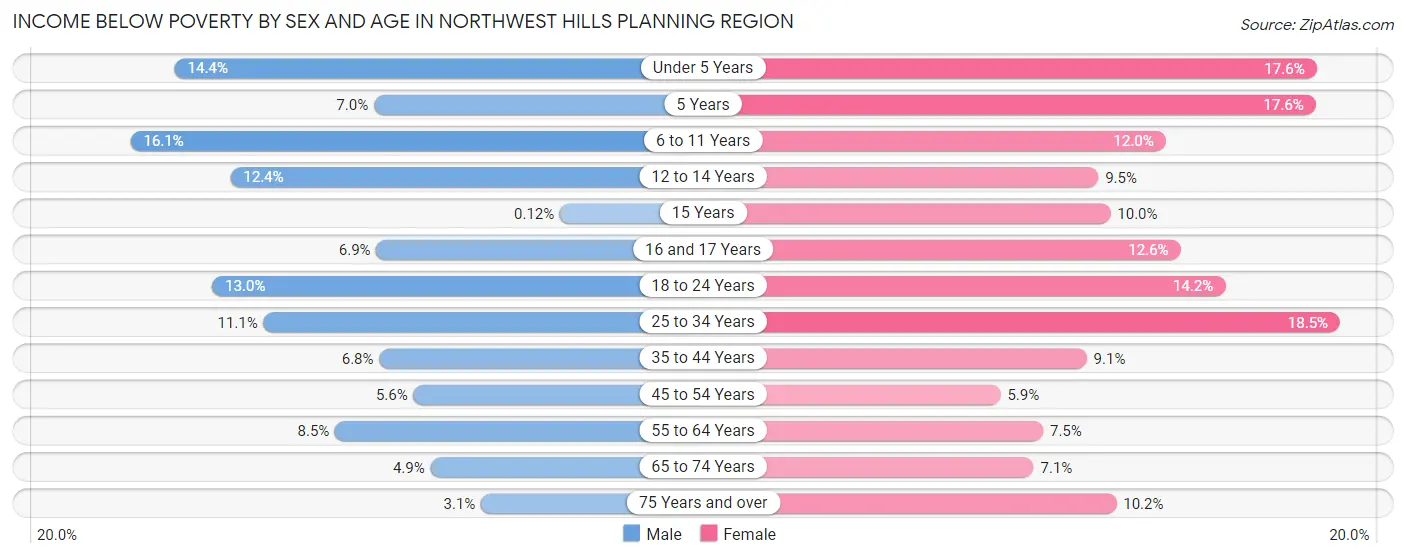
| Age Bracket | Male | Female |
| Under 5 Years | 398 (14.4%) | 368 (17.6%) |
| 5 Years | 35 (7.0%) | 86 (17.6%) |
| 6 to 11 Years | 561 (16.1%) | 424 (12.0%) |
| 12 to 14 Years | 248 (12.4%) | 157 (9.5%) |
| 15 Years | 1 (0.1%) | 86 (10.0%) |
| 16 and 17 Years | 94 (6.9%) | 162 (12.6%) |
| 18 to 24 Years | 566 (13.0%) | 551 (14.2%) |
| 25 to 34 Years | 743 (11.1%) | 1,201 (18.5%) |
| 35 to 44 Years | 452 (6.8%) | 580 (9.1%) |
| 45 to 54 Years | 410 (5.6%) | 454 (5.9%) |
| 55 to 64 Years | 741 (8.5%) | 709 (7.5%) |
| 65 to 74 Years | 331 (4.9%) | 478 (7.1%) |
| 75 Years and over | 119 (3.0%) | 507 (10.2%) |
| Total | 4,699 (8.5%) | 5,763 (10.4%) |
Income Above Poverty by Sex and Age in Northwest Hills Planning Region
According to the poverty statistics in Northwest Hills Planning Region, males aged 15 years and females aged 45 to 54 years are the age groups that are most secure financially, with 99.9% of males and 94.1% of females in these age groups living above the poverty line.
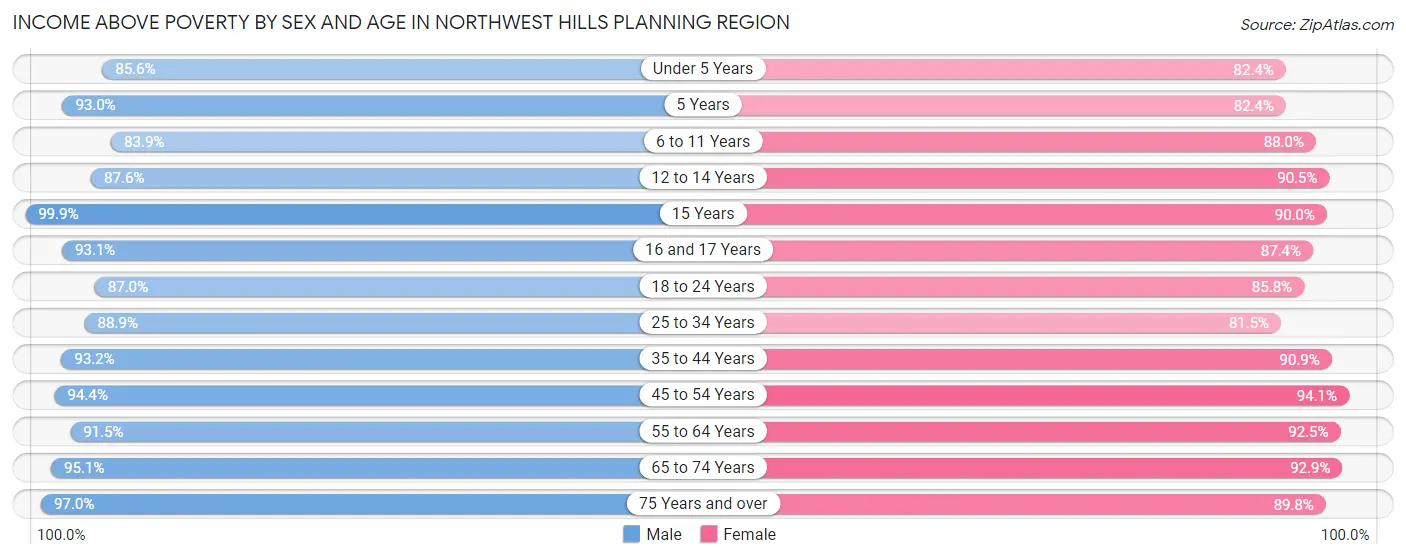
| Age Bracket | Male | Female |
| Under 5 Years | 2,361 (85.6%) | 1,721 (82.4%) |
| 5 Years | 463 (93.0%) | 403 (82.4%) |
| 6 to 11 Years | 2,931 (83.9%) | 3,103 (88.0%) |
| 12 to 14 Years | 1,759 (87.6%) | 1,493 (90.5%) |
| 15 Years | 846 (99.9%) | 777 (90.0%) |
| 16 and 17 Years | 1,260 (93.1%) | 1,127 (87.4%) |
| 18 to 24 Years | 3,774 (87.0%) | 3,322 (85.8%) |
| 25 to 34 Years | 5,930 (88.9%) | 5,294 (81.5%) |
| 35 to 44 Years | 6,162 (93.2%) | 5,804 (90.9%) |
| 45 to 54 Years | 6,969 (94.4%) | 7,252 (94.1%) |
| 55 to 64 Years | 8,007 (91.5%) | 8,782 (92.5%) |
| 65 to 74 Years | 6,378 (95.1%) | 6,239 (92.9%) |
| 75 Years and over | 3,780 (97.0%) | 4,470 (89.8%) |
| Total | 50,620 (91.5%) | 49,787 (89.6%) |
Income Below Poverty Among Married-Couple Families in Northwest Hills Planning Region
The poverty statistics for married-couple families in Northwest Hills Planning Region show that 2.3% or 523 of the total 22,670 families live below the poverty line. Families with 5 or more children have the highest poverty rate of 37.5%, comprising of 6 families. On the other hand, families with no children have the lowest poverty rate of 0.9%, which includes 130 families.

| Children | Above Poverty | Below Poverty |
| No Children | 14,763 (99.1%) | 130 (0.9%) |
| 1 or 2 Children | 6,279 (96.3%) | 243 (3.7%) |
| 3 or 4 Children | 1,095 (88.4%) | 144 (11.6%) |
| 5 or more Children | 10 (62.5%) | 6 (37.5%) |
| Total | 22,147 (97.7%) | 523 (2.3%) |
Income Below Poverty Among Single-Parent Households in Northwest Hills Planning Region
According to the poverty data in Northwest Hills Planning Region, 7.1% or 155 single-father households and 26.1% or 1,277 single-mother households are living below the poverty line. Among single-father households, those with 3 or 4 children have the highest poverty rate, with 44 households (40.4%) experiencing poverty. Likewise, among single-mother households, those with 1 or 2 children have the highest poverty rate, with 891 households (37.5%) falling below the poverty line.

| Children | Single Father | Single Mother |
| No Children | 106 (12.5%) | 208 (11.5%) |
| 1 or 2 Children | 5 (0.4%) | 891 (37.5%) |
| 3 or 4 Children | 44 (40.4%) | 178 (25.0%) |
| 5 or more Children | 0 (0.0%) | 0 (0.0%) |
| Total | 155 (7.1%) | 1,277 (26.1%) |
Income Below Poverty Among Married-Couple vs Single-Parent Households in Northwest Hills Planning Region
The poverty data for Northwest Hills Planning Region shows that 523 of the married-couple family households (2.3%) and 1,432 of the single-parent households (20.3%) are living below the poverty level. Within the married-couple family households, those with 5 or more children have the highest poverty rate, with 6 households (37.5%) falling below the poverty line. Among the single-parent households, those with 3 or 4 children have the highest poverty rate, with 222 household (27.0%) living below poverty.

| Children | Married-Couple Families | Single-Parent Households |
| No Children | 130 (0.9%) | 314 (11.8%) |
| 1 or 2 Children | 243 (3.7%) | 896 (25.1%) |
| 3 or 4 Children | 144 (11.6%) | 222 (27.0%) |
| 5 or more Children | 6 (37.5%) | 0 (0.0%) |
| Total | 523 (2.3%) | 1,432 (20.3%) |
Employment Characteristics in Northwest Hills Planning Region
Employment by Class of Employer in Northwest Hills Planning Region
Among the 56,900 employed individuals in Northwest Hills Planning Region, private company employees (36,247 | 63.7%), not-for-profit organizations (5,927 | 10.4%), and self-employed (not incorporated) (4,906 | 8.6%) make up the most common classes of employment.

| Employer Class | # Employees | % Employees |
| Private Company Employees | 36,247 | 63.7% |
| Self-Employed (Incorporated) | 2,628 | 4.6% |
| Self-Employed (Not Incorporated) | 4,906 | 8.6% |
| Not-for-profit Organizations | 5,927 | 10.4% |
| Local Government Employees | 4,687 | 8.2% |
| State Government Employees | 1,643 | 2.9% |
| Federal Government Employees | 806 | 1.4% |
| Unpaid Family Workers | 56 | 0.1% |
| Total | 56,900 | 100.0% |
Employment Status by Age in Northwest Hills Planning Region
According to the labor force statistics for Northwest Hills Planning Region, out of the total population over 16 years of age (93,842), 65.4% or 61,373 individuals are in the labor force, with 5.4% or 3,314 of them unemployed. The age group with the highest labor force participation rate is 35 to 44 years, with 88.0% or 11,443 individuals in the labor force. Within the labor force, the 16 to 19 years age range has the highest percentage of unemployed individuals, with 14.2% or 314 of them being unemployed.

| Age Bracket | In Labor Force | Unemployed |
| 16 to 19 Years | 2,213 (41.8%) | 314 (14.2%) |
| 20 to 24 Years | 4,390 (74.8%) | 408 (9.3%) |
| 25 to 29 Years | 5,508 (85.4%) | 441 (8.0%) |
| 30 to 34 Years | 5,881 (87.2%) | 241 (4.1%) |
| 35 to 44 Years | 11,443 (88.0%) | 561 (4.9%) |
| 45 to 54 Years | 12,571 (83.0%) | 503 (4.0%) |
| 55 to 59 Years | 6,970 (83.7%) | 188 (2.7%) |
| 60 to 64 Years | 6,594 (66.1%) | 356 (5.4%) |
| 65 to 74 Years | 4,741 (35.0%) | 261 (5.5%) |
| 75 Years and over | 1,006 (10.6%) | 15 (1.5%) |
| Total | 61,373 (65.4%) | 3,314 (5.4%) |
Employment Status by Educational Attainment in Northwest Hills Planning Region
According to labor force statistics for Northwest Hills Planning Region, 82.1% of individuals (48,969) out of the total population between 25 and 64 years of age (59,646) are in the labor force, with 4.7% or 2,302 of them being unemployed. The group with the highest labor force participation rate are those with the educational attainment of bachelor's degree or higher, with 88.2% or 19,800 individuals in the labor force. Within the labor force, individuals with less than high school education have the highest percentage of unemployment, with 8.3% or 205 of them being unemployed.

| Educational Attainment | In Labor Force | Unemployed |
| Less than High School | 2,466 (66.6%) | 307 (8.3%) |
| High School Diploma | 12,956 (74.9%) | 917 (5.3%) |
| College / Associate Degree | 13,751 (84.9%) | 1,101 (6.8%) |
| Bachelor's Degree or higher | 19,800 (88.2%) | 516 (2.3%) |
| Total | 48,969 (82.1%) | 2,803 (4.7%) |
Employment Occupations by Sex in Northwest Hills Planning Region
Management, Business, Science and Arts Occupations
The most common Management, Business, Science and Arts occupations in Northwest Hills Planning Region are Community & Social Service (7,941 | 13.7%), Management (7,448 | 12.8%), Education Instruction & Library (4,551 | 7.9%), Health Diagnosing & Treating (3,716 | 6.4%), and Computers, Engineering & Science (3,388 | 5.8%).
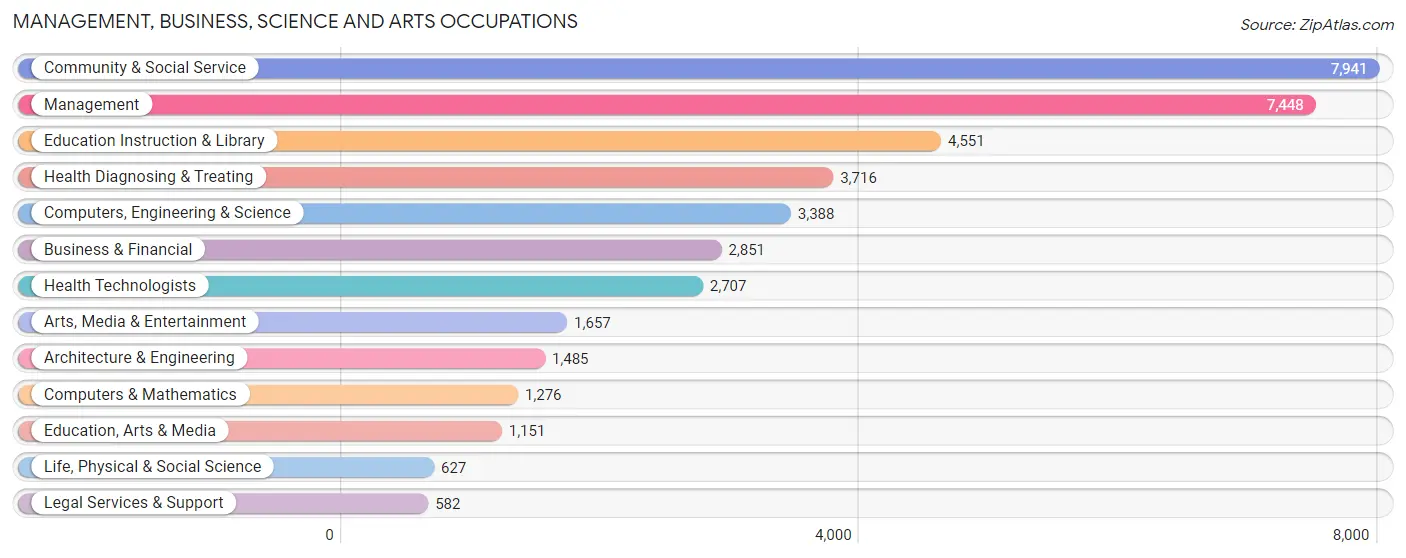
Management, Business, Science and Arts Occupations by Sex
Within the Management, Business, Science and Arts occupations in Northwest Hills Planning Region, the most male-oriented occupations are Architecture & Engineering (85.4%), Computers & Mathematics (75.9%), and Computers, Engineering & Science (74.6%), while the most female-oriented occupations are Education Instruction & Library (78.9%), Health Diagnosing & Treating (77.6%), and Health Technologists (76.2%).

| Occupation | Male | Female |
| Management | 4,300 (57.7%) | 3,148 (42.3%) |
| Business & Financial | 1,097 (38.5%) | 1,754 (61.5%) |
| Computers, Engineering & Science | 2,527 (74.6%) | 861 (25.4%) |
| Computers & Mathematics | 968 (75.9%) | 308 (24.1%) |
| Architecture & Engineering | 1,268 (85.4%) | 217 (14.6%) |
| Life, Physical & Social Science | 291 (46.4%) | 336 (53.6%) |
| Community & Social Service | 2,524 (31.8%) | 5,417 (68.2%) |
| Education, Arts & Media | 420 (36.5%) | 731 (63.5%) |
| Legal Services & Support | 227 (39.0%) | 355 (61.0%) |
| Education Instruction & Library | 961 (21.1%) | 3,590 (78.9%) |
| Arts, Media & Entertainment | 916 (55.3%) | 741 (44.7%) |
| Health Diagnosing & Treating | 833 (22.4%) | 2,883 (77.6%) |
| Health Technologists | 645 (23.8%) | 2,062 (76.2%) |
| Total (Category) | 11,281 (44.5%) | 14,063 (55.5%) |
| Total (Overall) | 30,236 (52.1%) | 27,751 (47.9%) |
Services Occupations
The most common Services occupations in Northwest Hills Planning Region are Food Preparation & Serving (2,598 | 4.5%), Healthcare Support (2,441 | 4.2%), Cleaning & Maintenance (2,394 | 4.1%), Personal Care & Service (1,626 | 2.8%), and Security & Protection (927 | 1.6%).

Services Occupations by Sex
Within the Services occupations in Northwest Hills Planning Region, the most male-oriented occupations are Law Enforcement (94.9%), Security & Protection (89.2%), and Firefighting & Prevention (82.8%), while the most female-oriented occupations are Healthcare Support (86.3%), Personal Care & Service (78.2%), and Food Preparation & Serving (55.8%).

| Occupation | Male | Female |
| Healthcare Support | 334 (13.7%) | 2,107 (86.3%) |
| Security & Protection | 827 (89.2%) | 100 (10.8%) |
| Firefighting & Prevention | 361 (82.8%) | 75 (17.2%) |
| Law Enforcement | 466 (94.9%) | 25 (5.1%) |
| Food Preparation & Serving | 1,149 (44.2%) | 1,449 (55.8%) |
| Cleaning & Maintenance | 1,842 (76.9%) | 552 (23.1%) |
| Personal Care & Service | 355 (21.8%) | 1,271 (78.2%) |
| Total (Category) | 4,507 (45.1%) | 5,479 (54.9%) |
| Total (Overall) | 30,236 (52.1%) | 27,751 (47.9%) |
Sales and Office Occupations
The most common Sales and Office occupations in Northwest Hills Planning Region are Sales & Related (5,656 | 9.8%), and Office & Administration (5,172 | 8.9%).

Sales and Office Occupations by Sex

| Occupation | Male | Female |
| Sales & Related | 3,161 (55.9%) | 2,495 (44.1%) |
| Office & Administration | 1,329 (25.7%) | 3,843 (74.3%) |
| Total (Category) | 4,490 (41.5%) | 6,338 (58.5%) |
| Total (Overall) | 30,236 (52.1%) | 27,751 (47.9%) |
Natural Resources, Construction and Maintenance Occupations
The most common Natural Resources, Construction and Maintenance occupations in Northwest Hills Planning Region are Construction & Extraction (3,400 | 5.9%), Installation, Maintenance & Repair (1,731 | 3.0%), and Farming, Fishing & Forestry (300 | 0.5%).

Natural Resources, Construction and Maintenance Occupations by Sex

| Occupation | Male | Female |
| Farming, Fishing & Forestry | 256 (85.3%) | 44 (14.7%) |
| Construction & Extraction | 3,346 (98.4%) | 54 (1.6%) |
| Installation, Maintenance & Repair | 1,694 (97.9%) | 37 (2.1%) |
| Total (Category) | 5,296 (97.5%) | 135 (2.5%) |
| Total (Overall) | 30,236 (52.1%) | 27,751 (47.9%) |
Production, Transportation and Moving Occupations
The most common Production, Transportation and Moving occupations in Northwest Hills Planning Region are Production (3,348 | 5.8%), Transportation (1,813 | 3.1%), and Material Moving (1,237 | 2.1%).

Production, Transportation and Moving Occupations by Sex

| Occupation | Male | Female |
| Production | 2,592 (77.4%) | 756 (22.6%) |
| Transportation | 1,264 (69.7%) | 549 (30.3%) |
| Material Moving | 806 (65.2%) | 431 (34.8%) |
| Total (Category) | 4,662 (72.9%) | 1,736 (27.1%) |
| Total (Overall) | 30,236 (52.1%) | 27,751 (47.9%) |
Employment Industries by Sex in Northwest Hills Planning Region
Employment Industries in Northwest Hills Planning Region
The major employment industries in Northwest Hills Planning Region include Health Care & Social Assistance (9,155 | 15.8%), Manufacturing (6,677 | 11.5%), Educational Services (6,537 | 11.3%), Retail Trade (5,662 | 9.8%), and Construction (4,931 | 8.5%).
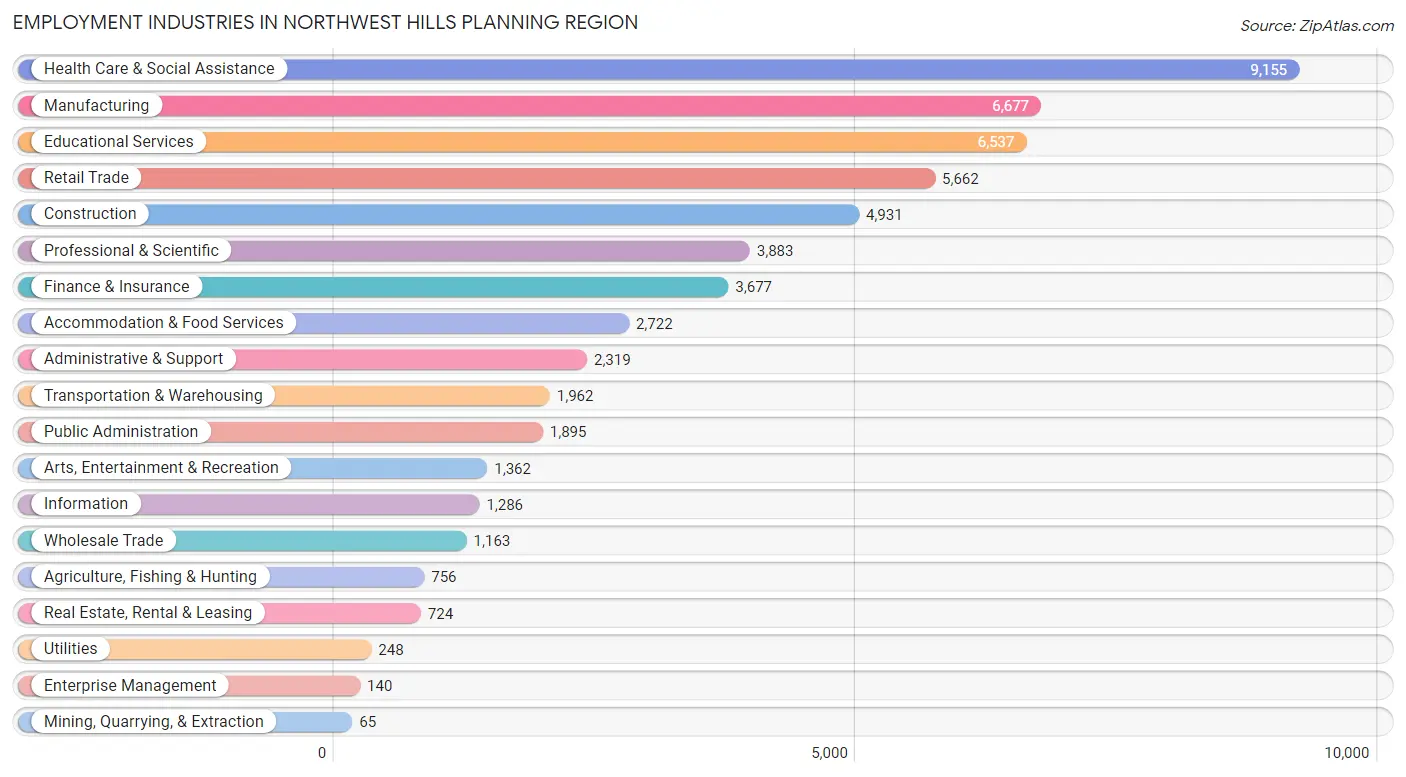
Employment Industries by Sex in Northwest Hills Planning Region
The Northwest Hills Planning Region industries that see more men than women are Utilities (96.4%), Mining, Quarrying, & Extraction (95.4%), and Enterprise Management (92.9%), whereas the industries that tend to have a higher number of women are Health Care & Social Assistance (78.9%), Educational Services (68.1%), and Finance & Insurance (59.0%).
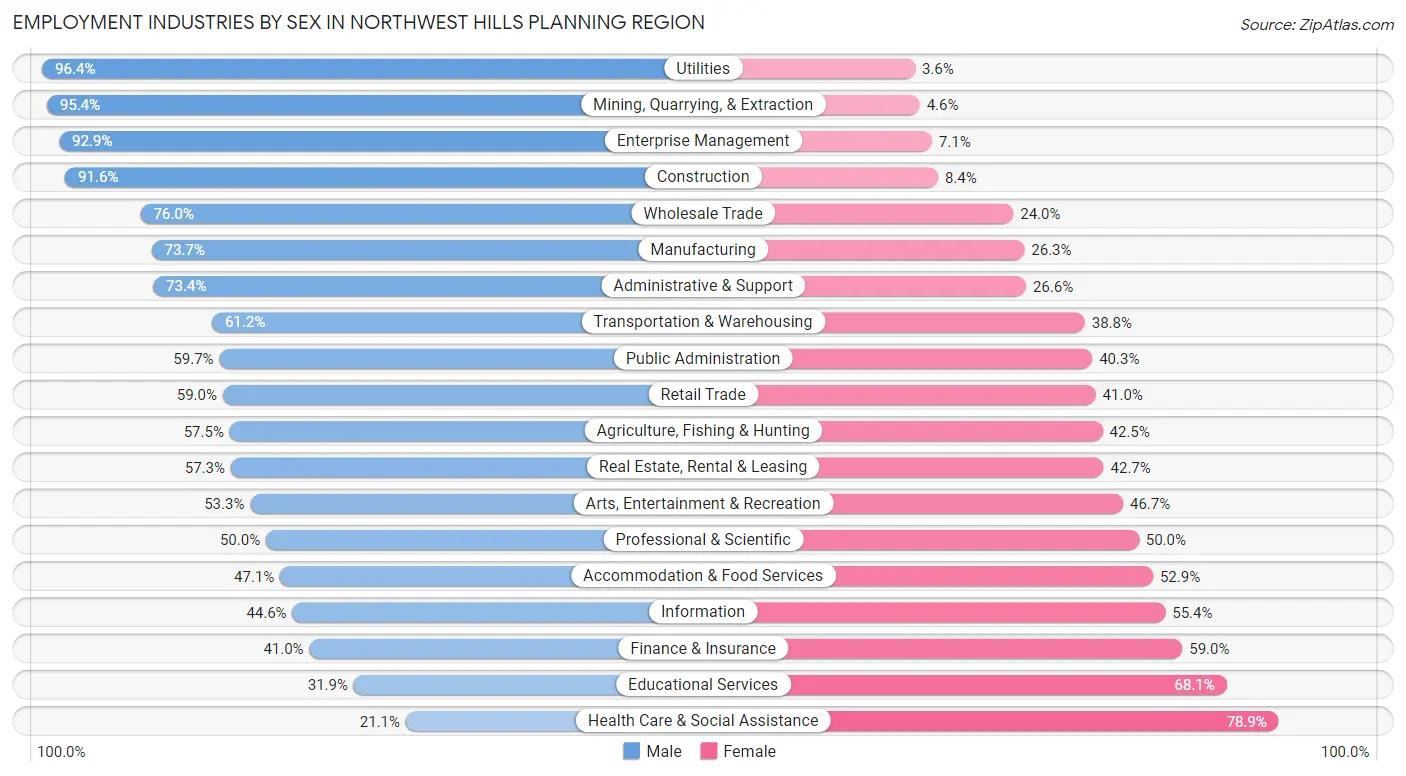
| Industry | Male | Female |
| Agriculture, Fishing & Hunting | 435 (57.5%) | 321 (42.5%) |
| Mining, Quarrying, & Extraction | 62 (95.4%) | 3 (4.6%) |
| Construction | 4,517 (91.6%) | 414 (8.4%) |
| Manufacturing | 4,922 (73.7%) | 1,755 (26.3%) |
| Wholesale Trade | 884 (76.0%) | 279 (24.0%) |
| Retail Trade | 3,339 (59.0%) | 2,323 (41.0%) |
| Transportation & Warehousing | 1,201 (61.2%) | 761 (38.8%) |
| Utilities | 239 (96.4%) | 9 (3.6%) |
| Information | 573 (44.6%) | 713 (55.4%) |
| Finance & Insurance | 1,509 (41.0%) | 2,168 (59.0%) |
| Real Estate, Rental & Leasing | 415 (57.3%) | 309 (42.7%) |
| Professional & Scientific | 1,943 (50.0%) | 1,940 (50.0%) |
| Enterprise Management | 130 (92.9%) | 10 (7.1%) |
| Administrative & Support | 1,702 (73.4%) | 617 (26.6%) |
| Educational Services | 2,083 (31.9%) | 4,454 (68.1%) |
| Health Care & Social Assistance | 1,931 (21.1%) | 7,224 (78.9%) |
| Arts, Entertainment & Recreation | 726 (53.3%) | 636 (46.7%) |
| Accommodation & Food Services | 1,282 (47.1%) | 1,440 (52.9%) |
| Public Administration | 1,131 (59.7%) | 764 (40.3%) |
| Total | 30,236 (52.1%) | 27,751 (47.9%) |
Education in Northwest Hills Planning Region
School Enrollment in Northwest Hills Planning Region
The most common levels of schooling among the 23,857 students in Northwest Hills Planning Region are high school (6,192 | 26.0%), middle school (5,058 | 21.2%), and elementary school (4,562 | 19.1%).

| School Level | # Students | % Students |
| Nursery / Preschool | 1,487 | 6.2% |
| Kindergarten | 946 | 4.0% |
| Elementary School | 4,562 | 19.1% |
| Middle School | 5,058 | 21.2% |
| High School | 6,192 | 26.0% |
| College / Undergraduate | 4,459 | 18.7% |
| Graduate / Professional | 1,153 | 4.8% |
| Total | 23,857 | 100.0% |
School Enrollment by Age by Funding Source in Northwest Hills Planning Region
Out of a total of 23,857 students who are enrolled in schools in Northwest Hills Planning Region, 4,485 (18.8%) attend a private institution, while the remaining 19,372 (81.2%) are enrolled in public schools. The age group of 20 to 24 year olds has the highest likelihood of being enrolled in private schools, with 987 (43.1% in the age bracket) enrolled. Conversely, the age group of 5 to 9 year old has the lowest likelihood of being enrolled in a private school, with 4,978 (90.8% in the age bracket) attending a public institution.

| Age Bracket | Public School | Private School |
| 3 to 4 Year Olds | 751 (60.6%) | 488 (39.4%) |
| 5 to 9 Year Old | 4,978 (90.8%) | 504 (9.2%) |
| 10 to 14 Year Olds | 5,423 (87.3%) | 788 (12.7%) |
| 15 to 17 Year Olds | 3,684 (86.0%) | 598 (14.0%) |
| 18 to 19 Year Olds | 1,587 (79.8%) | 401 (20.2%) |
| 20 to 24 Year Olds | 1,303 (56.9%) | 987 (43.1%) |
| 25 to 34 Year Olds | 608 (74.5%) | 208 (25.5%) |
| 35 Years and over | 1,041 (67.2%) | 508 (32.8%) |
| Total | 19,372 (81.2%) | 4,485 (18.8%) |
Educational Attainment by Field of Study in Northwest Hills Planning Region
Business (4,816 | 14.1%), education (4,203 | 12.3%), science & technology (3,356 | 9.8%), social sciences (3,353 | 9.8%), and literature & languages (2,561 | 7.5%) are the most common fields of study among 34,129 individuals in Northwest Hills Planning Region who have obtained a bachelor's degree or higher.
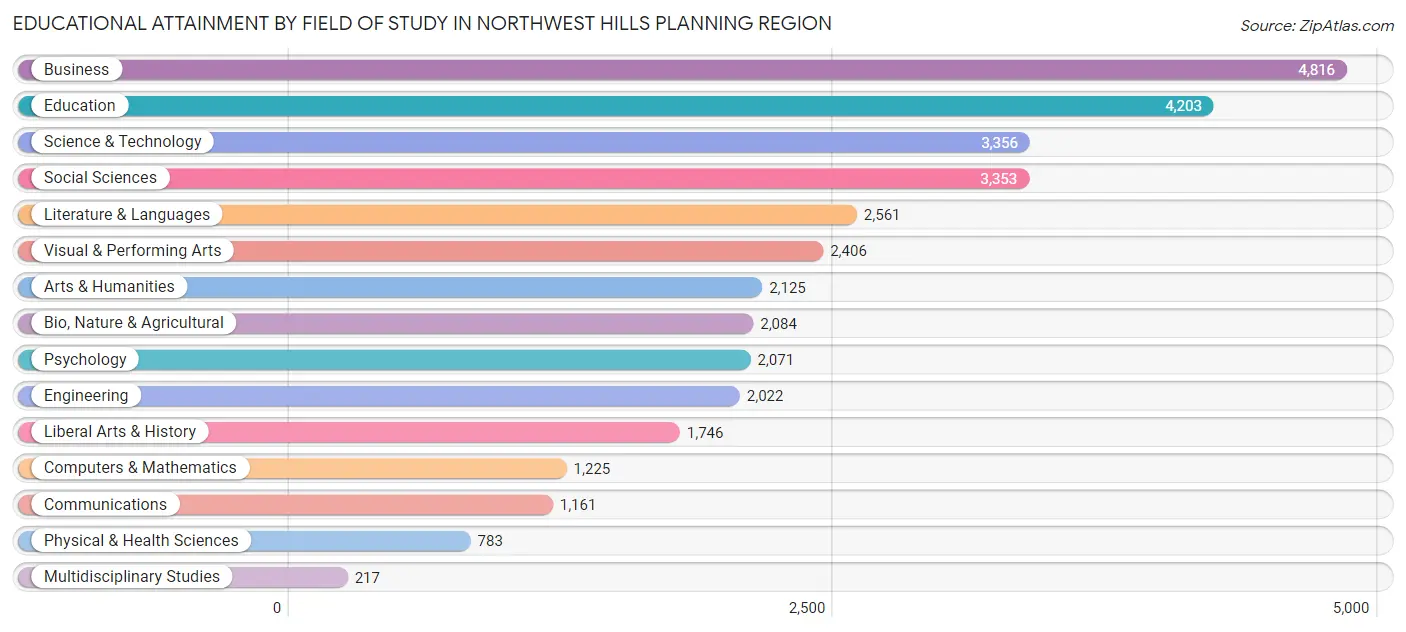
| Field of Study | # Graduates | % Graduates |
| Computers & Mathematics | 1,225 | 3.6% |
| Bio, Nature & Agricultural | 2,084 | 6.1% |
| Physical & Health Sciences | 783 | 2.3% |
| Psychology | 2,071 | 6.1% |
| Social Sciences | 3,353 | 9.8% |
| Engineering | 2,022 | 5.9% |
| Multidisciplinary Studies | 217 | 0.6% |
| Science & Technology | 3,356 | 9.8% |
| Business | 4,816 | 14.1% |
| Education | 4,203 | 12.3% |
| Literature & Languages | 2,561 | 7.5% |
| Liberal Arts & History | 1,746 | 5.1% |
| Visual & Performing Arts | 2,406 | 7.0% |
| Communications | 1,161 | 3.4% |
| Arts & Humanities | 2,125 | 6.2% |
| Total | 34,129 | 100.0% |
Transportation & Commute in Northwest Hills Planning Region
Vehicle Availability by Sex in Northwest Hills Planning Region
The most prevalent vehicle ownership categories in Northwest Hills Planning Region are males with 2 vehicles (12,315, accounting for 41.6%) and females with 2 vehicles (10,587, making up 45.8%).

| Vehicles Available | Male | Female |
| No Vehicle | 570 (1.9%) | 805 (3.0%) |
| 1 Vehicle | 4,714 (15.9%) | 5,542 (20.6%) |
| 2 Vehicles | 12,315 (41.6%) | 10,587 (39.3%) |
| 3 Vehicles | 7,033 (23.8%) | 6,412 (23.8%) |
| 4 Vehicles | 2,980 (10.1%) | 2,323 (8.6%) |
| 5 or more Vehicles | 1,953 (6.6%) | 1,240 (4.6%) |
| Total | 29,565 (100.0%) | 26,909 (100.0%) |
Commute Time in Northwest Hills Planning Region
The most frequently occuring commute durations in Northwest Hills Planning Region are 15 to 19 minutes (6,215 commuters, 12.4%), 10 to 14 minutes (6,106 commuters, 12.2%), and 20 to 24 minutes (6,023 commuters, 12.0%).
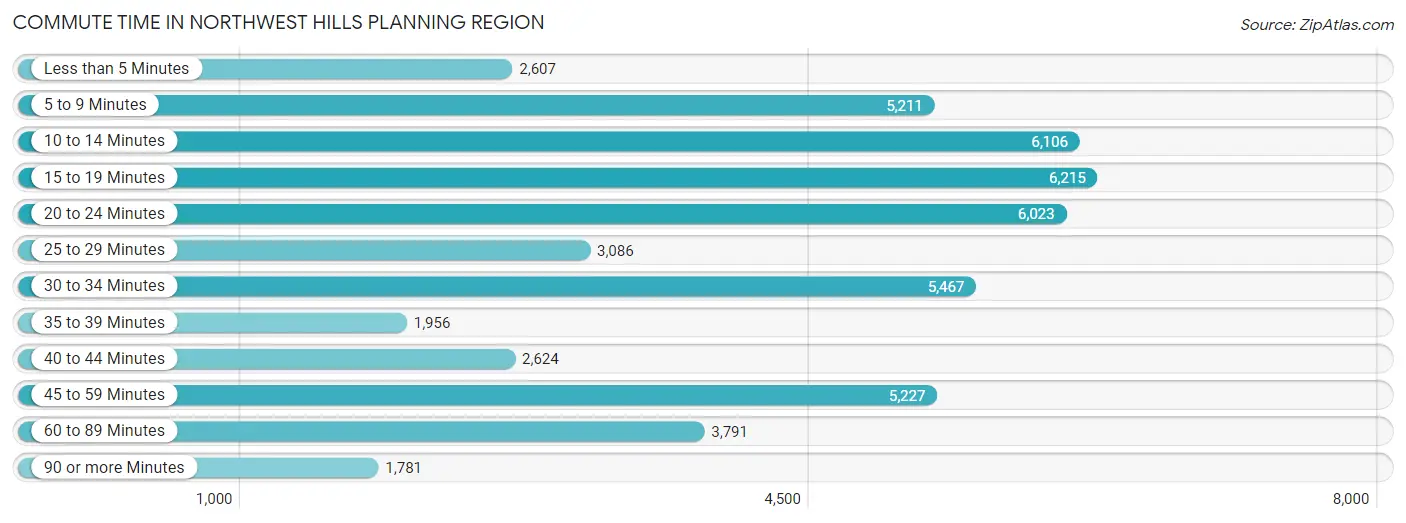
| Commute Time | # Commuters | % Commuters |
| Less than 5 Minutes | 2,607 | 5.2% |
| 5 to 9 Minutes | 5,211 | 10.4% |
| 10 to 14 Minutes | 6,106 | 12.2% |
| 15 to 19 Minutes | 6,215 | 12.4% |
| 20 to 24 Minutes | 6,023 | 12.0% |
| 25 to 29 Minutes | 3,086 | 6.2% |
| 30 to 34 Minutes | 5,467 | 10.9% |
| 35 to 39 Minutes | 1,956 | 3.9% |
| 40 to 44 Minutes | 2,624 | 5.2% |
| 45 to 59 Minutes | 5,227 | 10.4% |
| 60 to 89 Minutes | 3,791 | 7.6% |
| 90 or more Minutes | 1,781 | 3.6% |
Commute Time by Sex in Northwest Hills Planning Region
The most common commute times in Northwest Hills Planning Region are 20 to 24 minutes (3,248 commuters, 12.2%) for males and 10 to 14 minutes (3,373 commuters, 14.3%) for females.
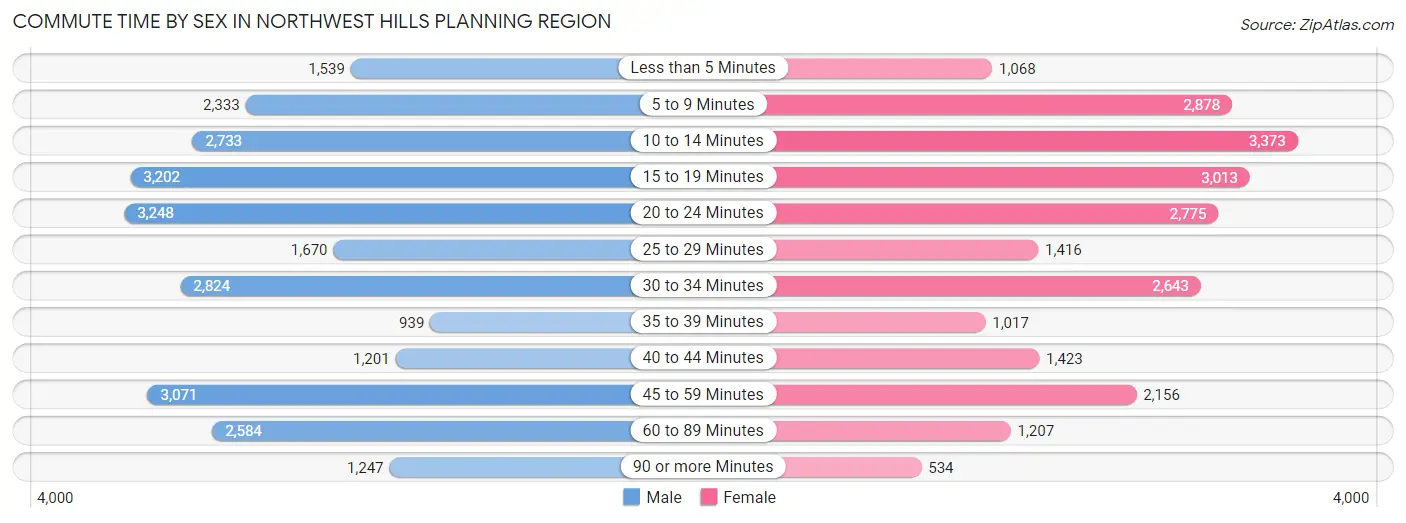
| Commute Time | Male | Female |
| Less than 5 Minutes | 1,539 (5.8%) | 1,068 (4.5%) |
| 5 to 9 Minutes | 2,333 (8.8%) | 2,878 (12.2%) |
| 10 to 14 Minutes | 2,733 (10.3%) | 3,373 (14.3%) |
| 15 to 19 Minutes | 3,202 (12.0%) | 3,013 (12.8%) |
| 20 to 24 Minutes | 3,248 (12.2%) | 2,775 (11.8%) |
| 25 to 29 Minutes | 1,670 (6.3%) | 1,416 (6.0%) |
| 30 to 34 Minutes | 2,824 (10.6%) | 2,643 (11.3%) |
| 35 to 39 Minutes | 939 (3.5%) | 1,017 (4.3%) |
| 40 to 44 Minutes | 1,201 (4.5%) | 1,423 (6.0%) |
| 45 to 59 Minutes | 3,071 (11.6%) | 2,156 (9.2%) |
| 60 to 89 Minutes | 2,584 (9.7%) | 1,207 (5.1%) |
| 90 or more Minutes | 1,247 (4.7%) | 534 (2.3%) |
Time of Departure to Work by Sex in Northwest Hills Planning Region
The most frequent times of departure to work in Northwest Hills Planning Region are 7:00 AM to 7:29 AM (3,598, 13.5%) for males and 7:30 AM to 7:59 AM (3,929, 16.7%) for females.
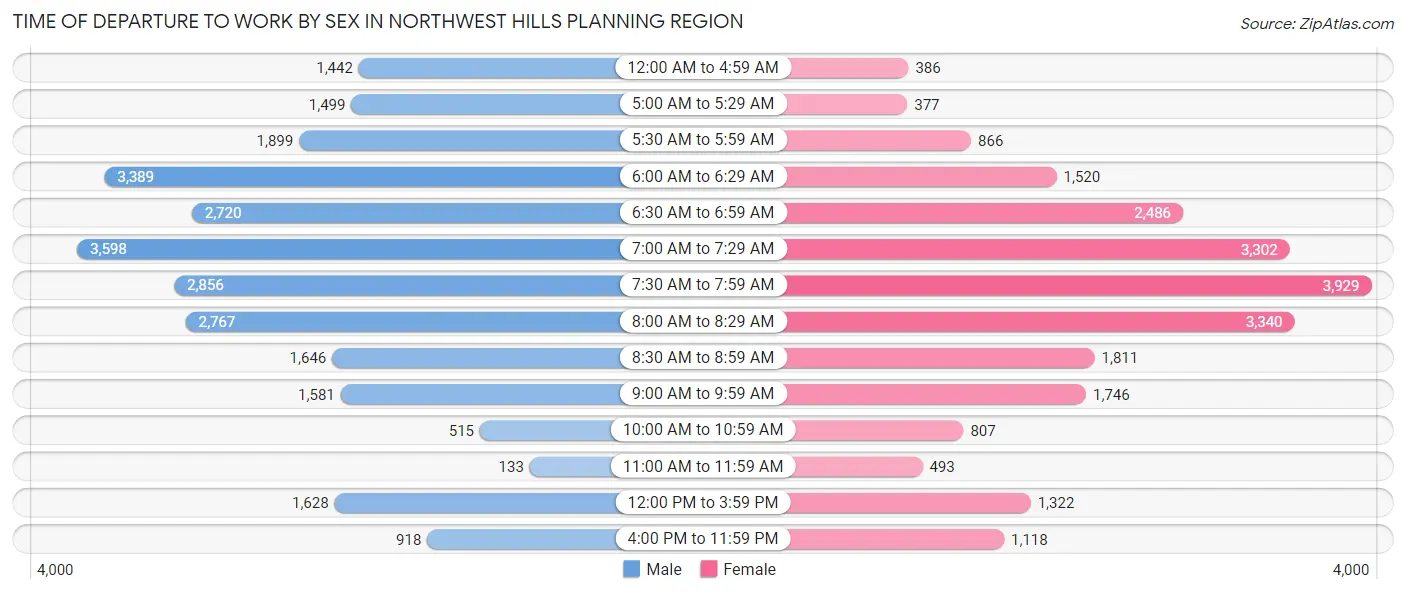
| Time of Departure | Male | Female |
| 12:00 AM to 4:59 AM | 1,442 (5.4%) | 386 (1.6%) |
| 5:00 AM to 5:29 AM | 1,499 (5.6%) | 377 (1.6%) |
| 5:30 AM to 5:59 AM | 1,899 (7.1%) | 866 (3.7%) |
| 6:00 AM to 6:29 AM | 3,389 (12.7%) | 1,520 (6.5%) |
| 6:30 AM to 6:59 AM | 2,720 (10.2%) | 2,486 (10.6%) |
| 7:00 AM to 7:29 AM | 3,598 (13.5%) | 3,302 (14.1%) |
| 7:30 AM to 7:59 AM | 2,856 (10.7%) | 3,929 (16.7%) |
| 8:00 AM to 8:29 AM | 2,767 (10.4%) | 3,340 (14.2%) |
| 8:30 AM to 8:59 AM | 1,646 (6.2%) | 1,811 (7.7%) |
| 9:00 AM to 9:59 AM | 1,581 (5.9%) | 1,746 (7.4%) |
| 10:00 AM to 10:59 AM | 515 (1.9%) | 807 (3.4%) |
| 11:00 AM to 11:59 AM | 133 (0.5%) | 493 (2.1%) |
| 12:00 PM to 3:59 PM | 1,628 (6.1%) | 1,322 (5.6%) |
| 4:00 PM to 11:59 PM | 918 (3.5%) | 1,118 (4.8%) |
| Total | 26,591 (100.0%) | 23,503 (100.0%) |
Housing Occupancy in Northwest Hills Planning Region
Occupancy by Ownership in Northwest Hills Planning Region
Of the total 45,976 dwellings in Northwest Hills Planning Region, owner-occupied units account for 34,234 (74.5%), while renter-occupied units make up 11,742 (25.5%).

| Occupancy | # Housing Units | % Housing Units |
| Owner Occupied Housing Units | 34,234 | 74.5% |
| Renter-Occupied Housing Units | 11,742 | 25.5% |
| Total Occupied Housing Units | 45,976 | 100.0% |
Occupancy by Household Size in Northwest Hills Planning Region

| Household Size | # Housing Units | % Housing Units |
| 1-Person Household | 13,092 | 28.5% |
| 2-Person Household | 16,913 | 36.8% |
| 3-Person Household | 7,124 | 15.5% |
| 4+ Person Household | 8,847 | 19.2% |
| Total Housing Units | 45,976 | 100.0% |
Occupancy by Ownership by Household Size in Northwest Hills Planning Region

| Household Size | Owner-occupied | Renter-occupied |
| 1-Person Household | 8,167 (62.4%) | 4,925 (37.6%) |
| 2-Person Household | 13,891 (82.1%) | 3,022 (17.9%) |
| 3-Person Household | 5,455 (76.6%) | 1,669 (23.4%) |
| 4+ Person Household | 6,721 (76.0%) | 2,126 (24.0%) |
| Total Housing Units | 34,234 (74.5%) | 11,742 (25.5%) |
Occupancy by Educational Attainment in Northwest Hills Planning Region

| Household Size | Owner-occupied | Renter-occupied |
| Less than High School | 1,155 (44.7%) | 1,429 (55.3%) |
| High School Diploma | 8,202 (68.3%) | 3,798 (31.7%) |
| College/Associate Degree | 9,311 (73.5%) | 3,362 (26.5%) |
| Bachelor's Degree or higher | 15,566 (83.2%) | 3,153 (16.8%) |
Occupancy by Age of Householder in Northwest Hills Planning Region

| Age Bracket | # Households | % Households |
| Under 35 Years | 5,487 | 11.9% |
| 35 to 44 Years | 6,890 | 15.0% |
| 45 to 54 Years | 8,399 | 18.3% |
| 55 to 64 Years | 10,515 | 22.9% |
| 65 to 74 Years | 8,406 | 18.3% |
| 75 to 84 Years | 4,124 | 9.0% |
| 85 Years and Over | 2,155 | 4.7% |
| Total | 45,976 | 100.0% |
Housing Finances in Northwest Hills Planning Region
Median Income by Occupancy in Northwest Hills Planning Region

| Occupancy Type | # Households | Median Income |
| Owner-Occupied | 34,234 (74.5%) | $105,201 |
| Renter-Occupied | 11,742 (25.5%) | $47,717 |
| Average | 45,976 (100.0%) | $87,971 |
Occupancy by Householder Income Bracket in Northwest Hills Planning Region
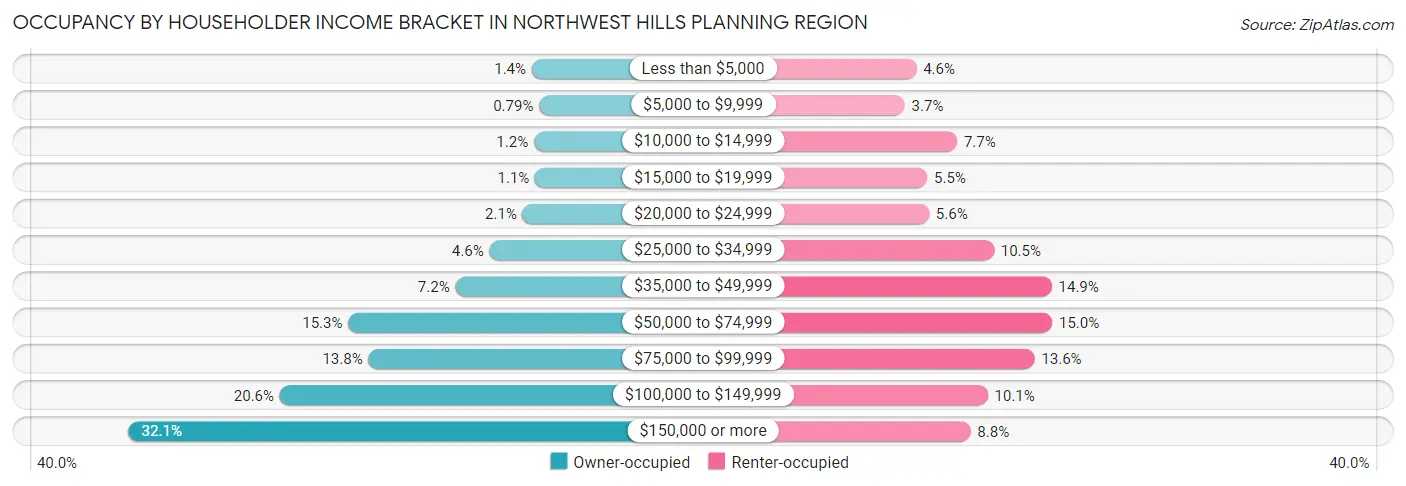
| Income Bracket | Owner-occupied | Renter-occupied |
| Less than $5,000 | 463 (1.3%) | 542 (4.6%) |
| $5,000 to $9,999 | 272 (0.8%) | 439 (3.7%) |
| $10,000 to $14,999 | 406 (1.2%) | 908 (7.7%) |
| $15,000 to $19,999 | 376 (1.1%) | 640 (5.4%) |
| $20,000 to $24,999 | 703 (2.1%) | 656 (5.6%) |
| $25,000 to $34,999 | 1,569 (4.6%) | 1,237 (10.5%) |
| $35,000 to $49,999 | 2,453 (7.2%) | 1,754 (14.9%) |
| $50,000 to $74,999 | 5,253 (15.3%) | 1,758 (15.0%) |
| $75,000 to $99,999 | 4,724 (13.8%) | 1,600 (13.6%) |
| $100,000 to $149,999 | 7,036 (20.5%) | 1,181 (10.1%) |
| $150,000 or more | 10,979 (32.1%) | 1,027 (8.7%) |
| Total | 34,234 (100.0%) | 11,742 (100.0%) |
Monthly Housing Cost Tiers in Northwest Hills Planning Region

| Monthly Cost | Owner-occupied | Renter-occupied |
| Less than $300 | 272 (0.8%) | 314 (2.7%) |
| $300 to $499 | 655 (1.9%) | 515 (4.4%) |
| $500 to $799 | 3,844 (11.2%) | 1,100 (9.4%) |
| $800 to $999 | 3,248 (9.5%) | 1,708 (14.5%) |
| $1,000 to $1,499 | 7,492 (21.9%) | 4,355 (37.1%) |
| $1,500 to $1,999 | 6,221 (18.2%) | 1,690 (14.4%) |
| $2,000 to $2,499 | 4,533 (13.2%) | 650 (5.5%) |
| $2,500 to $2,999 | 2,995 (8.7%) | 120 (1.0%) |
| $3,000 or more | 4,974 (14.5%) | 300 (2.5%) |
| Total | 34,234 (100.0%) | 11,742 (100.0%) |
Physical Housing Characteristics in Northwest Hills Planning Region
Housing Structures in Northwest Hills Planning Region

| Structure Type | # Housing Units | % Housing Units |
| Single Unit, Detached | 34,399 | 74.8% |
| Single Unit, Attached | 1,808 | 3.9% |
| 2 Unit Apartments | 3,125 | 6.8% |
| 3 or 4 Unit Apartments | 2,639 | 5.7% |
| 5 to 9 Unit Apartments | 1,530 | 3.3% |
| 10 or more Apartments | 2,427 | 5.3% |
| Mobile Home / Other | 48 | 0.1% |
| Total | 45,976 | 100.0% |
Housing Structures by Occupancy in Northwest Hills Planning Region

| Structure Type | Owner-occupied | Renter-occupied |
| Single Unit, Detached | 31,243 (90.8%) | 3,156 (9.2%) |
| Single Unit, Attached | 1,053 (58.2%) | 755 (41.8%) |
| 2 Unit Apartments | 968 (31.0%) | 2,157 (69.0%) |
| 3 or 4 Unit Apartments | 340 (12.9%) | 2,299 (87.1%) |
| 5 to 9 Unit Apartments | 340 (22.2%) | 1,190 (77.8%) |
| 10 or more Apartments | 250 (10.3%) | 2,177 (89.7%) |
| Mobile Home / Other | 40 (83.3%) | 8 (16.7%) |
| Total | 34,234 (74.5%) | 11,742 (25.5%) |
Housing Structures by Number of Rooms in Northwest Hills Planning Region

| Number of Rooms | Owner-occupied | Renter-occupied |
| 1 Room | 96 (0.3%) | 591 (5.0%) |
| 2 or 3 Rooms | 578 (1.7%) | 2,588 (22.0%) |
| 4 or 5 Rooms | 8,246 (24.1%) | 5,075 (43.2%) |
| 6 or 7 Rooms | 13,894 (40.6%) | 2,301 (19.6%) |
| 8 or more Rooms | 11,420 (33.4%) | 1,187 (10.1%) |
| Total | 34,234 (100.0%) | 11,742 (100.0%) |
Housing Structure by Heating Type in Northwest Hills Planning Region

| Heating Type | Owner-occupied | Renter-occupied |
| Utility Gas | 4,013 (11.7%) | 3,462 (29.5%) |
| Bottled, Tank, or LP Gas | 3,188 (9.3%) | 913 (7.8%) |
| Electricity | 2,466 (7.2%) | 3,177 (27.1%) |
| Fuel Oil or Kerosene | 21,717 (63.4%) | 3,840 (32.7%) |
| Coal or Coke | 37 (0.1%) | 0 (0.0%) |
| All other Fuels | 2,712 (7.9%) | 301 (2.6%) |
| No Fuel Used | 101 (0.3%) | 49 (0.4%) |
| Total | 34,234 (100.0%) | 11,742 (100.0%) |
Household Vehicle Usage in Northwest Hills Planning Region

| Vehicles per Household | Owner-occupied | Renter-occupied |
| No Vehicle | 731 (2.1%) | 2,093 (17.8%) |
| 1 Vehicle | 8,859 (25.9%) | 5,394 (45.9%) |
| 2 Vehicles | 14,394 (42.0%) | 3,428 (29.2%) |
| 3 or more Vehicles | 10,250 (29.9%) | 827 (7.0%) |
| Total | 34,234 (100.0%) | 11,742 (100.0%) |
Real Estate & Mortgages in Northwest Hills Planning Region
Real Estate and Mortgage Overview in Northwest Hills Planning Region
| Characteristic | Without Mortgage | With Mortgage |
| Housing Units | 12,328 | 21,906 |
| Median Property Value | $293,300 | $298,800 |
| Median Household Income | $89,161 | $7,467 |
| Monthly Housing Costs | $918 | $4,750 |
| Real Estate Taxes | $5,534 | $185 |
Property Value by Mortgage Status in Northwest Hills Planning Region

| Property Value | Without Mortgage | With Mortgage |
| Less than $50,000 | 359 (2.9%) | 399 (1.8%) |
| $50,000 to $99,999 | 553 (4.5%) | 356 (1.6%) |
| $100,000 to $299,999 | 5,421 (44.0%) | 10,252 (46.8%) |
| $300,000 to $499,999 | 3,392 (27.5%) | 6,745 (30.8%) |
| $500,000 to $749,999 | 1,240 (10.1%) | 2,428 (11.1%) |
| $750,000 to $999,999 | 524 (4.3%) | 628 (2.9%) |
| $1,000,000 or more | 839 (6.8%) | 1,098 (5.0%) |
| Total | 12,328 (100.0%) | 21,906 (100.0%) |
Household Income by Mortgage Status in Northwest Hills Planning Region

| Household Income | Without Mortgage | With Mortgage |
| Less than $10,000 | 334 (2.7%) | 563 (2.6%) |
| $10,000 to $24,999 | 856 (6.9%) | 401 (1.8%) |
| $25,000 to $34,999 | 877 (7.1%) | 629 (2.9%) |
| $35,000 to $49,999 | 1,113 (9.0%) | 692 (3.2%) |
| $50,000 to $74,999 | 2,074 (16.8%) | 1,340 (6.1%) |
| $75,000 to $99,999 | 1,533 (12.4%) | 3,179 (14.5%) |
| $100,000 to $149,999 | 2,029 (16.5%) | 3,191 (14.6%) |
| $150,000 or more | 3,512 (28.5%) | 5,007 (22.9%) |
| Total | 12,328 (100.0%) | 21,906 (100.0%) |
Property Value to Household Income Ratio in Northwest Hills Planning Region

| Value-to-Income Ratio | Without Mortgage | With Mortgage |
| Less than 2.0x | 3,557 (28.8%) | 114,030 (520.5%) |
| 2.0x to 2.9x | 2,299 (18.6%) | 8,077 (36.9%) |
| 3.0x to 3.9x | 1,342 (10.9%) | 4,807 (21.9%) |
| 4.0x or more | 5,064 (41.1%) | 3,022 (13.8%) |
| Total | 12,328 (100.0%) | 21,906 (100.0%) |
Real Estate Taxes by Mortgage Status in Northwest Hills Planning Region

| Property Taxes | Without Mortgage | With Mortgage |
| Less than $800 | 277 (2.2%) | 24 (0.1%) |
| $800 to $1,499 | 266 (2.2%) | 374 (1.7%) |
| $800 to $1,499 | 11,535 (93.6%) | 347 (1.6%) |
| Total | 12,328 (100.0%) | 21,906 (100.0%) |
Health & Disability in Northwest Hills Planning Region
Health Insurance Coverage by Age in Northwest Hills Planning Region

| Age Bracket | With Coverage | Without Coverage |
| Under 6 Years | 5,966 (99.1%) | 55 (0.9%) |
| 6 to 18 Years | 16,488 (97.1%) | 493 (2.9%) |
| 19 to 25 Years | 7,428 (92.6%) | 590 (7.4%) |
| 26 to 34 Years | 10,964 (91.0%) | 1,088 (9.0%) |
| 35 to 44 Years | 11,928 (91.8%) | 1,067 (8.2%) |
| 45 to 54 Years | 14,581 (96.7%) | 493 (3.3%) |
| 55 to 64 Years | 17,483 (95.9%) | 756 (4.1%) |
| 65 to 74 Years | 13,387 (99.7%) | 39 (0.3%) |
| 75 Years and older | 8,876 (100.0%) | 0 (0.0%) |
| Total | 107,101 (95.9%) | 4,581 (4.1%) |
Health Insurance Coverage by Citizenship Status in Northwest Hills Planning Region

| Citizenship Status | With Coverage | Without Coverage |
| Native Born | 5,966 (99.1%) | 55 (0.9%) |
| Foreign Born, Citizen | 16,488 (97.1%) | 493 (2.9%) |
| Foreign Born, not a Citizen | 7,428 (92.6%) | 590 (7.4%) |
Health Insurance Coverage by Household Income in Northwest Hills Planning Region

| Household Income | With Coverage | Without Coverage |
| Under $25,000 | 8,456 (91.7%) | 761 (8.3%) |
| $25,000 to $49,999 | 12,041 (93.1%) | 892 (6.9%) |
| $50,000 to $74,999 | 13,181 (94.2%) | 811 (5.8%) |
| $75,000 to $99,999 | 14,499 (96.6%) | 516 (3.4%) |
| $100,000 and over | 57,647 (97.3%) | 1,597 (2.7%) |
Public vs Private Health Insurance Coverage by Age in Northwest Hills Planning Region

| Age Bracket | Public Insurance | Private Insurance |
| Under 6 | 2,400 (39.9%) | 3,897 (64.7%) |
| 6 to 18 Years | 5,322 (31.3%) | 11,977 (70.5%) |
| 19 to 25 Years | 2,084 (26.0%) | 5,611 (70.0%) |
| 25 to 34 Years | 3,030 (25.1%) | 8,335 (69.2%) |
| 35 to 44 Years | 2,171 (16.7%) | 10,147 (78.1%) |
| 45 to 54 Years | 3,117 (20.7%) | 11,938 (79.2%) |
| 55 to 64 Years | 3,786 (20.8%) | 14,547 (79.8%) |
| 65 to 74 Years | 12,616 (94.0%) | 7,262 (54.1%) |
| 75 Years and over | 8,754 (98.6%) | 5,353 (60.3%) |
| Total | 43,280 (38.8%) | 79,067 (70.8%) |
Disability Status by Sex by Age in Northwest Hills Planning Region

| Age Bracket | Male | Female |
| Under 5 Years | 0 (0.0%) | 7 (0.3%) |
| 5 to 17 Years | 581 (6.9%) | 453 (5.6%) |
| 18 to 34 Years | 922 (8.3%) | 571 (5.4%) |
| 35 to 64 Years | 2,503 (11.0%) | 2,429 (10.3%) |
| 65 to 74 Years | 1,234 (18.4%) | 989 (14.7%) |
| 75 Years and over | 1,487 (38.1%) | 2,106 (42.3%) |
Disability Class by Sex by Age in Northwest Hills Planning Region
Disability Class: Hearing Difficulty

| Age Bracket | Male | Female |
| Under 5 Years | 0 (0.0%) | 0 (0.0%) |
| 5 to 17 Years | 189 (2.2%) | 0 (0.0%) |
| 18 to 34 Years | 154 (1.4%) | 38 (0.4%) |
| 35 to 64 Years | 741 (3.3%) | 640 (2.7%) |
| 65 to 74 Years | 730 (10.9%) | 184 (2.7%) |
| 75 Years and over | 947 (24.3%) | 876 (17.6%) |
Disability Class: Vision Difficulty

| Age Bracket | Male | Female |
| Under 5 Years | 0 (0.0%) | 7 (0.3%) |
| 5 to 17 Years | 49 (0.6%) | 35 (0.4%) |
| 18 to 34 Years | 35 (0.3%) | 69 (0.7%) |
| 35 to 64 Years | 245 (1.1%) | 483 (2.1%) |
| 65 to 74 Years | 110 (1.6%) | 147 (2.2%) |
| 75 Years and over | 263 (6.8%) | 407 (8.2%) |
Disability Class: Cognitive Difficulty

| Age Bracket | Male | Female |
| 5 to 17 Years | 379 (4.5%) | 410 (5.1%) |
| 18 to 34 Years | 586 (5.3%) | 469 (4.5%) |
| 35 to 64 Years | 1,044 (4.6%) | 1,060 (4.5%) |
| 65 to 74 Years | 153 (2.3%) | 169 (2.5%) |
| 75 Years and over | 555 (14.2%) | 718 (14.4%) |
Disability Class: Ambulatory Difficulty

| Age Bracket | Male | Female |
| 5 to 17 Years | 44 (0.5%) | 0 (0.0%) |
| 18 to 34 Years | 79 (0.7%) | 135 (1.3%) |
| 35 to 64 Years | 993 (4.4%) | 1,378 (5.8%) |
| 65 to 74 Years | 491 (7.3%) | 679 (10.1%) |
| 75 Years and over | 770 (19.8%) | 1,498 (30.1%) |
Disability Class: Self-Care Difficulty

| Age Bracket | Male | Female |
| 5 to 17 Years | 107 (1.3%) | 30 (0.4%) |
| 18 to 34 Years | 116 (1.0%) | 89 (0.9%) |
| 35 to 64 Years | 493 (2.2%) | 440 (1.9%) |
| 65 to 74 Years | 167 (2.5%) | 141 (2.1%) |
| 75 Years and over | 337 (8.6%) | 761 (15.3%) |
Technology Access in Northwest Hills Planning Region
Computing Device Access in Northwest Hills Planning Region

| Device Type | # Households | % Households |
| Desktop or Laptop | 38,143 | 83.0% |
| Smartphone | 39,222 | 85.3% |
| Tablet | 29,320 | 63.8% |
| No Computing Device | 2,763 | 6.0% |
| Total | 45,976 | 100.0% |
Internet Access in Northwest Hills Planning Region

| Internet Type | # Households | % Households |
| Dial-Up Internet | 203 | 0.4% |
| Broadband Home | 36,896 | 80.2% |
| Cellular Data Only | 3,622 | 7.9% |
| Satellite Internet | 1,794 | 3.9% |
| No Internet | 4,141 | 9.0% |
| Total | 45,976 | 100.0% |
Common Questions
What is the Total Population of Northwest Hills Planning Region?
Total Population of Northwest Hills Planning Region is 112,696.
What is the Total Male Population of Northwest Hills Planning Region?
Total Male Population of Northwest Hills Planning Region is 55,997.
What is the Total Female Population of Northwest Hills Planning Region?
Total Female Population of Northwest Hills Planning Region is 56,699.
What is the Ratio of Males per 100 Females in Northwest Hills Planning Region?
There are 98.76 Males per 100 Females in Northwest Hills Planning Region.
What is the Ratio of Females per 100 Males in Northwest Hills Planning Region?
There are 101.25 Females per 100 Males in Northwest Hills Planning Region.
What is the Median Population Age in Northwest Hills Planning Region?
Median Population Age in Northwest Hills Planning Region is 45.1 Years.
What is the Average Family Size in Northwest Hills Planning Region
Average Family Size in Northwest Hills Planning Region is 2.9 People.
What is the Average Household Size in Northwest Hills Planning Region
Average Household Size in Northwest Hills Planning Region is 2.4 People.
What is Per Capita Income in Northwest Hills Planning Region?
Per Capita income in Northwest Hills Planning Region is $52,279.
What is the Median Family Income in Northwest Hills Planning Region?
Median Family Income in Northwest Hills Planning Region is $108,548.
What is the Median Household income in Northwest Hills Planning Region?
Median Household Income in Northwest Hills Planning Region is $87,971.
What is Income or Wage Gap in Northwest Hills Planning Region?
Income or Wage Gap in Northwest Hills Planning Region is 25.3%.
Women in Northwest Hills Planning Region earn 74.7 cents for every dollar earned by a man.
What is Family Income Deficit in Northwest Hills Planning Region?
Family Income Deficit in Northwest Hills Planning Region is $10,773.
Families that are below poverty line in Northwest Hills Planning Region earn $10,773 less on average than the poverty threshold level.
What is Inequality or Gini Index in Northwest Hills Planning Region?
Inequality or Gini Index in Northwest Hills Planning Region is 0.48.
How Large is the Labor Force in Northwest Hills Planning Region?
There are 61,373 People in the Labor Forcein in Northwest Hills Planning Region.
What is the Percentage of People in the Labor Force in Northwest Hills Planning Region?
65.4% of People are in the Labor Force in Northwest Hills Planning Region.
What is the Unemployment Rate in Northwest Hills Planning Region?
Unemployment Rate in Northwest Hills Planning Region is 5.4%.